50 Types of Gems (With Pictures) – AZ Animals
Gems come in a vast rainbow of colors, clarity, and hardness. Some are soft and chalky while others can be honed to a scalpel-sharp edge.
We group gemstones roughly into categories like precious and semi-precious, but that doesn’t matter to those of us who love certain gems. For this, we searched for the most interesting and beautiful 50 gemstones — yes there really are that many!
The Gemological Institute of America analyzes and grades many commercially available stones, but they’re also a terrific educational resource. If you’re near one of their locations, check to see if they offer classes open to the public.
1. Agate
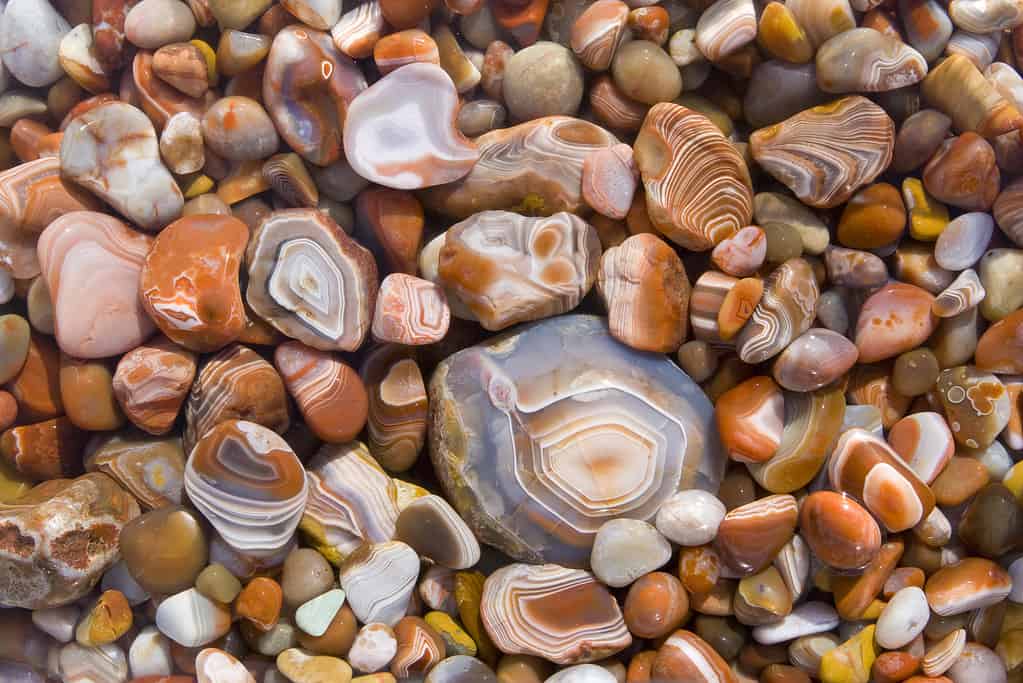
©Dennis O’Hara/Shutterstock.com
This stone is a chalcedony variety and displays moss-like inclusions, translucent areas, and color patterns. Agates can have multiple vivid colors — mostly the result of traces amounts of iron oxides, manganese, titanium, and other elements.
Most agates are hard enough that jewelers use it in all sorts of applications. It polishes up beautifully, and their interesting patterns add uniqueness to jewelry.
2. Alexandrite

©osinko/Shutterstock.com
One of a few color-changing types of gems, alexandrite is a chrysoberyl variety. It’s green in sunlight and purplish-red under incandescent light. Alexandrite’s cost is directly related to its color change and size. For example, an opaque cabochon that changes dramatically costs more than a really clear stone that only changes a little.
Russia’s Ural Mountains yielded the first alexandrite stones in the 1830s. However, miners nearly exhausted the original source after only a few decades. A few more sources emerged since the 1980s, but not enough to make the stone any less rare.
Despite its rarity, it’s on the birthstone list as an alternative to June’s pearl; and metaphysically, alexandrite may bring balance and strengthen creative abilities.
3. Amazonite
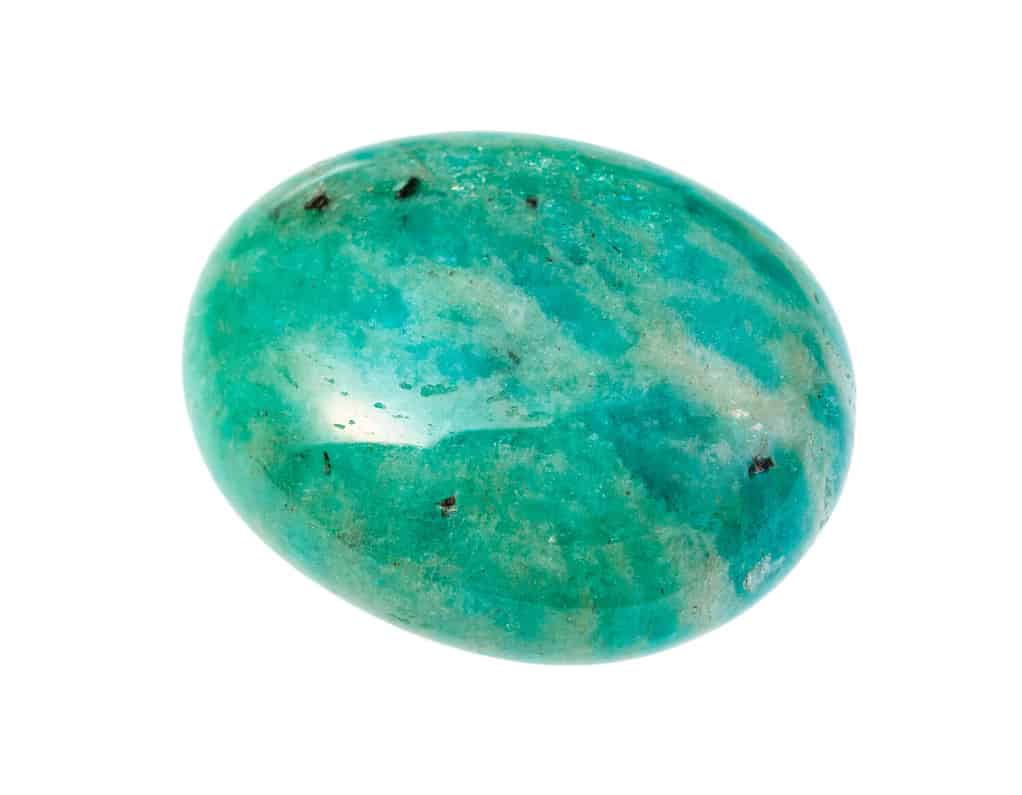
©vvoe/Shutterstock.com
This green-to-greenish-blue mineral is a type of feldspar. People have used it in jewelry for thousands of years, according to archaeological finds in Egypt and Mesopotamia. However, its hardness comes in at about 6.0 -6.5 on the Mohs scale, so it’s not as durable as other gemstones.
Amazonite occurs in multiple countries around the world, including Australia, China, Mongolia, South Africa, Libya, Sweden, and the United States. Its color comes from lead and water in the feldspar, although many people once assumed it was from copper.
Metaphysically, it’s used to balance extreme moods and may have a calming effect.
4. Amber

©Bjoern Wylezich/Shutterstock.com
Made famous by the Amber Room in the Catherine Palace and the Jurassic Park movies, amber is fossilized tree resin. Most gem-quality amber comes from a handful of locations, including the Baltic Sea and Myanmar. However, people have also found amber in Lebanon and Israel; even South America has amber deposits.
Most of the amber that artisans used in sturdier pieces like vases and larger carvings is from the countries around the Baltic Sea — Lithuania, Latvia, Russia, Sweden, Germany, Poland, and Denmark. The Greeks called it elektron, and, despite stories of it being produced by the sun, Pliny and his contemporaries knew that it originated as tree sap.
Amber comes in a range of colors from pale yellow to almost black, depending on its chemical makeup and the impurities present in its development. It’s known for being translucent and has yielded over 1,000 specimens from long-extinct animals, as well as plant matter that’s helped scientists understand more about the habitats where animals thrived.
5. Amethyst
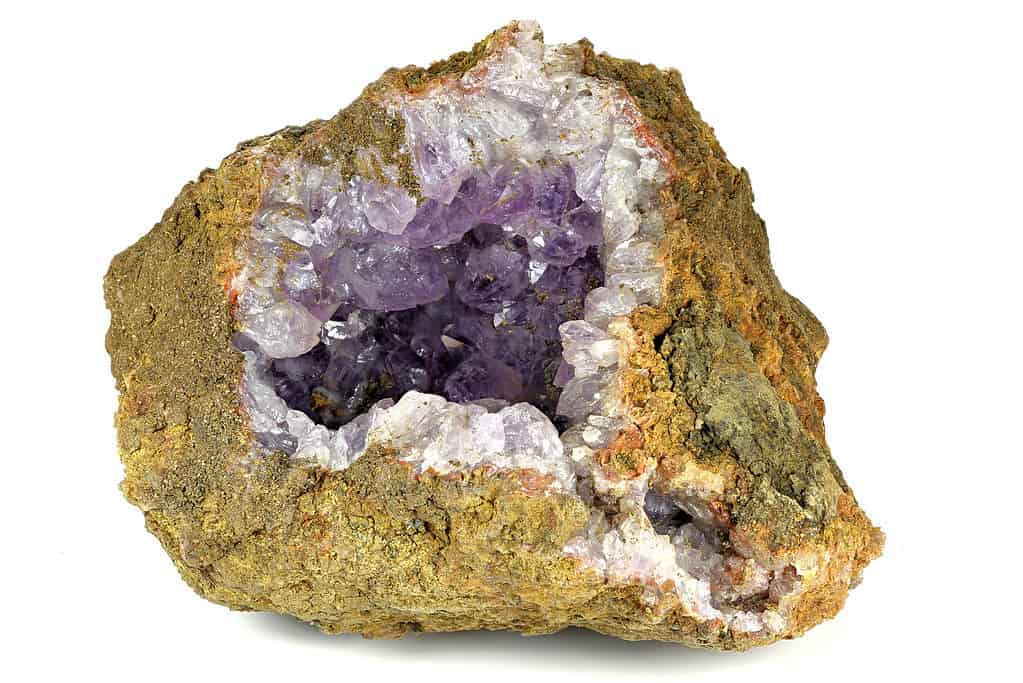
©Bjoern Wylezich/Shutterstock.com
One of the most widely-known types of gems, amethyst’s vibrant purple color makes gorgeous jewelry! This quartz variety sports a Mohs hardness of 7.0 and is one of February’s birthstones. Also, if you’re looking for a 6th or 17th wedding anniversary gift, amethyst is the traditional stone.
Thanks to its wine-like color, the Greeks associated it with the god of wine and pleasure — Dionysus —which also led to the belief that it kept the wearer free from drunkenness. However, some myths and legends said that it kept the wearer clear-headed in battle and business.
Amethyst gets its purple hue from the element manganese, which can vary depending on the amount of iron also present in the crystal.
Many people use amethyst to help quiet the mind and aid in meditation. Those who use it in their practice say that it helps enhance the crown and third-eye chakras and accelerates their development of intuitive abilities.
6. Ammolite
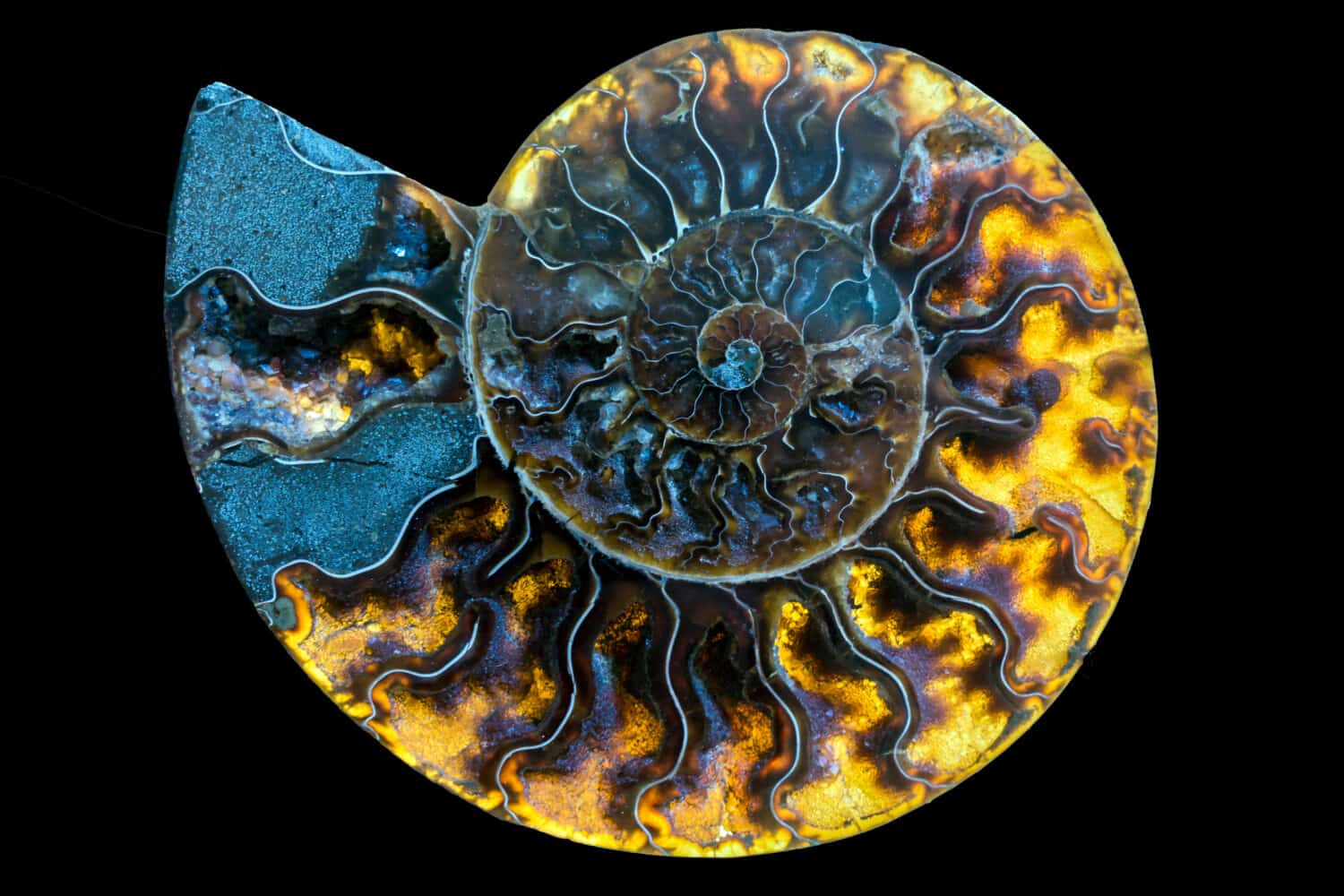
©Miroslav Halama/Shutterstock.com
Although it may sound like “ammonite,” the terms are often used interchangeably. However, technically speaking, the two are different, and “ammolite” only refers to gem-quality fossil shells.
These iridescent fossils appear in a dizzying array of colors that make beautiful jewelry. They were once marine mollusks that went extinct about 65 million years ago. Fossil hunters find ammonites around the world, but the only gem-quality fossils have ever been found in Alberta, Canada, in the Bearpaw Formation.
7. Azurite

©vvoe/Shutterstock.com
This beautiful, deep-blue mineral is what happens when copper ore deposits weather and oxidize. It’s soft and only registers 3.5 to 4 on the Mohs hardness scale. Azurite often occurs in the same areas as malachite but in smaller quantities.
It occurs naturally in the Eastern Desert of Egypt and in Sinai. Historically, people used it as a blue pigment for painting and other arts. However, because it’s essentially a stopping point between copper and malachite, azurite used in paint eventually becomes more green.
You’ll sometimes see it in jewelry and other decorative applications, but because it’s so soft and heat destroys azurite, mountings have to be done at room temperature.
Many cultures worldwide have used it as a guide-stone to help increase their connection to spirit and the otherworld. In addition, some believe that its deep blue color resonates with the third-eye chakra and serves as a guide for enlightenment.
8. Aquamarine

©KrimKate/Shutterstock.com
Clear blue to slightly greenish blue aquamarine is a favorite for many people! March’s birthstone is a beryl with a hardness of 7.5 to 8.0 on the Mohs scale — interestingly, emerald is also a beryl. Like many gemstones, beryl is naturally clear; impurities like the iron in aquamarine give them color.
This beautiful stone is mined worldwide, including in Mozambique, Madagascar, Nigeria, and Russia. However, most gem-quality stones are from Brazil.
Like other gemstones, people throughout history have ascribed different properties to aquamarine. Here are a few:
- Sailors carried aquamarine because they believed it helped calm the waves and keep them safe at sea.
- Some people believe it enhances marital happiness and is the traditional 19th wedding anniversary gift.
- Aquamarine is associated with faithfulness, friendship, and courage.
9. Chrysoberyl
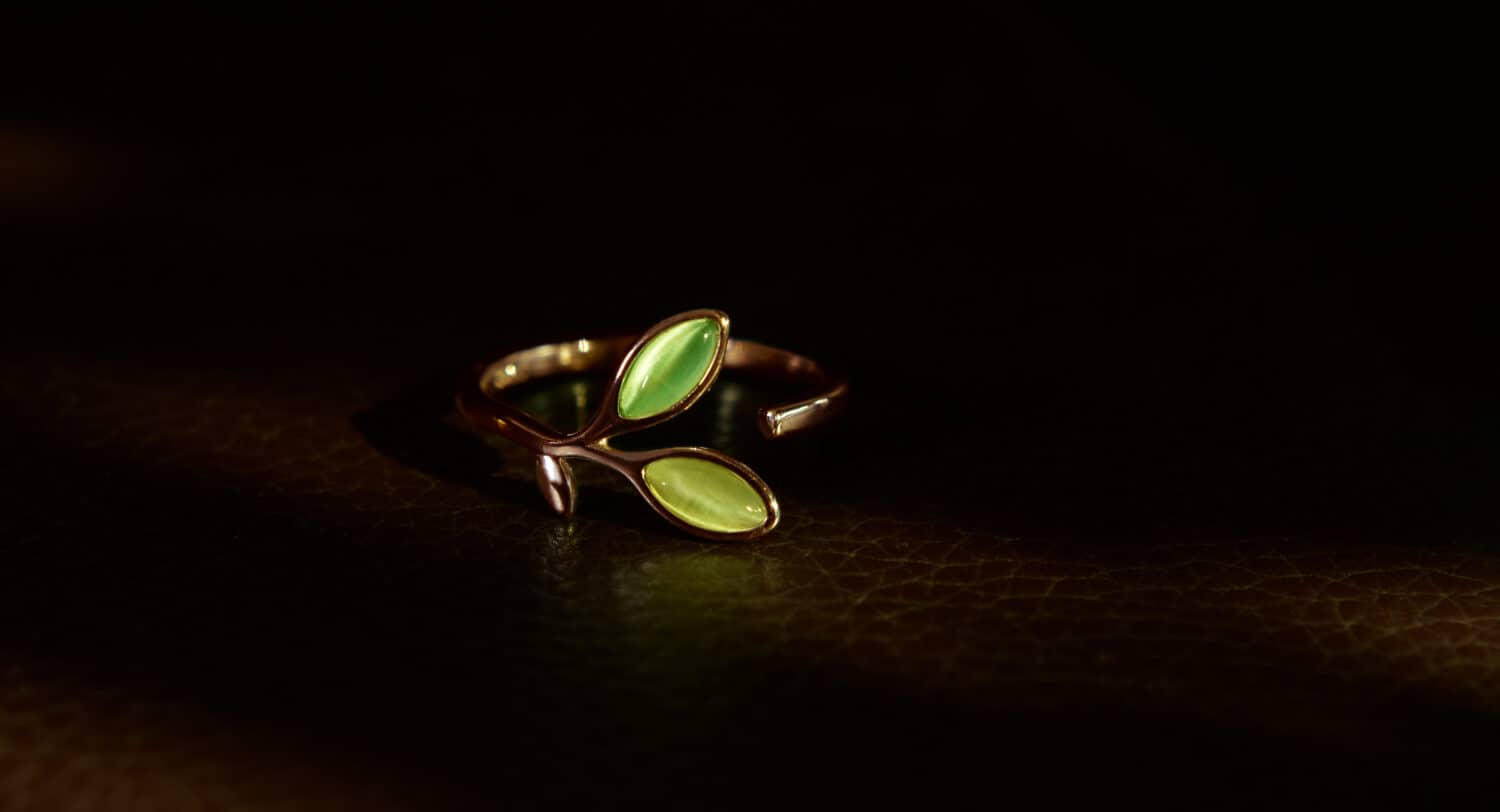
©Pesh Siri/Shutterstock.com
As one of the hardest stones, chrysoberyl comes in at an 8.5 on the Mohs hardness scale. It’s usually light-colored and can be yellow-brown, greenish-gray, greenish-brown, or gray. Sometimes, it even changes color in different lighting types, as in the case of Alexandrite — a type of chrysoberyl.
Chrysoberyl mines are found on most continents. As with aquamarine, the best deposits are in Brazil, but there are others in Australia, Madagascar, Myanmar, Russia, India, China, Sri Lanka, and Zimbabwe.
Crystal-healing proponents say that chrysoberyl has a gentle, compassionate energy that helps people stay grounded during stressful moments. It’s also believed to strengthen analytical skills, aid in planning and thinking strategically, and see our plans through to completion.
10. Bloodstone

© James St. John/CC BY 2.0 – License
This chalcedony variety has a long history! Bloodstone is dark green with a little red spatter throughout. Its hardness level is usually 6.5 and 7.0, making it great as cabochons and small sculptures. Indeed, polished bloodstone cabochon jewelry is lovely, and it’s one of March’s birthstones.
The most popular color pattern is green with blood-red dots that look like a random spray of blood. However, these are rare! Most of them have large areas of red and green with perhaps a few dots of blood red.
Some legends said that if you placed it in the rays of the setting sun or in water, it would turn the reflection of the sun to blood-red. Still, it’s often used for healing, and proponents say that it has a connection to blood and can help detox the organs — a belief that dates back to Mesopotamia 5,000 years ago.
11. Citrine
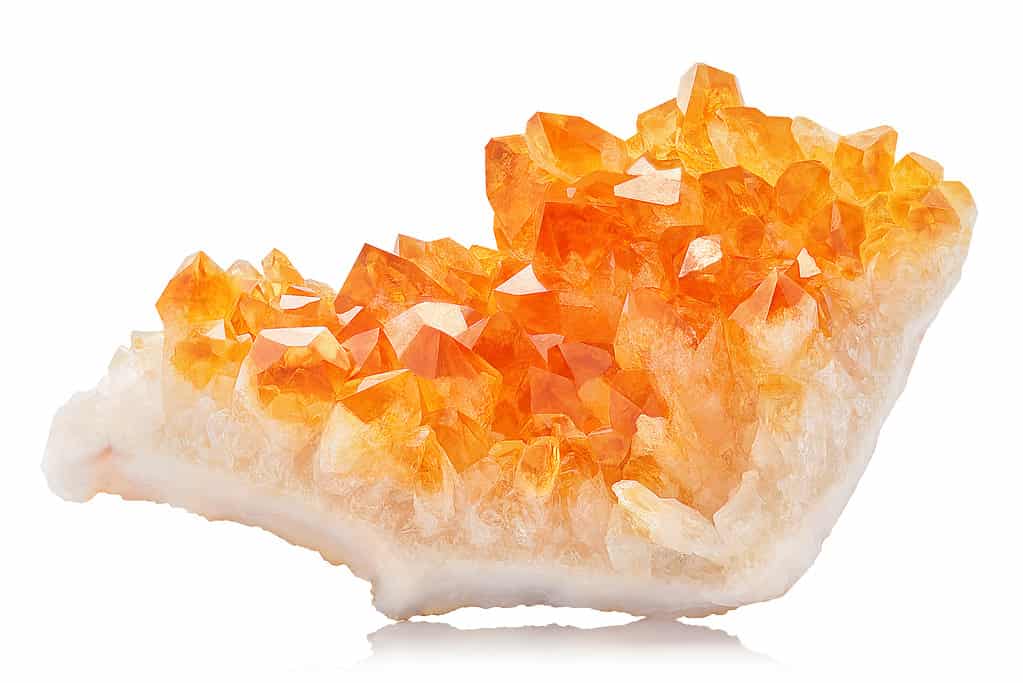
©Sebastian Janicki/Shutterstock.com
This gemstone’s yellow-orange hue sometimes gets it confused for topaz. However, citrine is relatively rare in nature and most stones marketed as citrine are heat-treated amethyst. This quartz gemstone ranges from pale yellow to reddish-orange with a brownish tint.
Most citrine originates in Spain, Madagascar, Bolivia, Mexico, and Uruguay. Additionally, citrine-mimicking, heat-treated amethyst also originates in those countries.
Because of its similarity to topaz, the two stones are often confused. Some believe that citrine and topaz can calm the wearer, and promote prosperity.
12. Carnelian
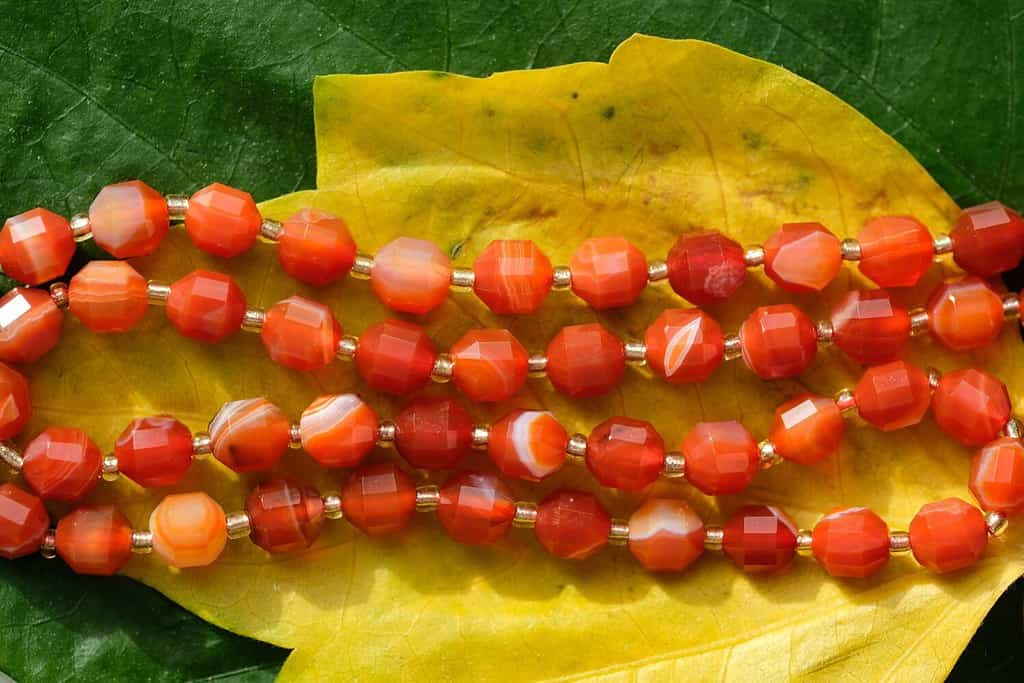
©MelaMari/Shutterstock.com
This chalcedony variety varies in color and can be yellow-orange, reddish-orange, orange-brown, and different shades in between. It’s fairly soft and easy to cut into cabochons and small jewels; historically, it was associated with kings, royalty, and even healing. Some even wear it to ward off the evil eye.
Most carnelian is mined in India, but gem-quality stones also occur in Brazil, Uruguay, and Egypt.
13. Haüyne
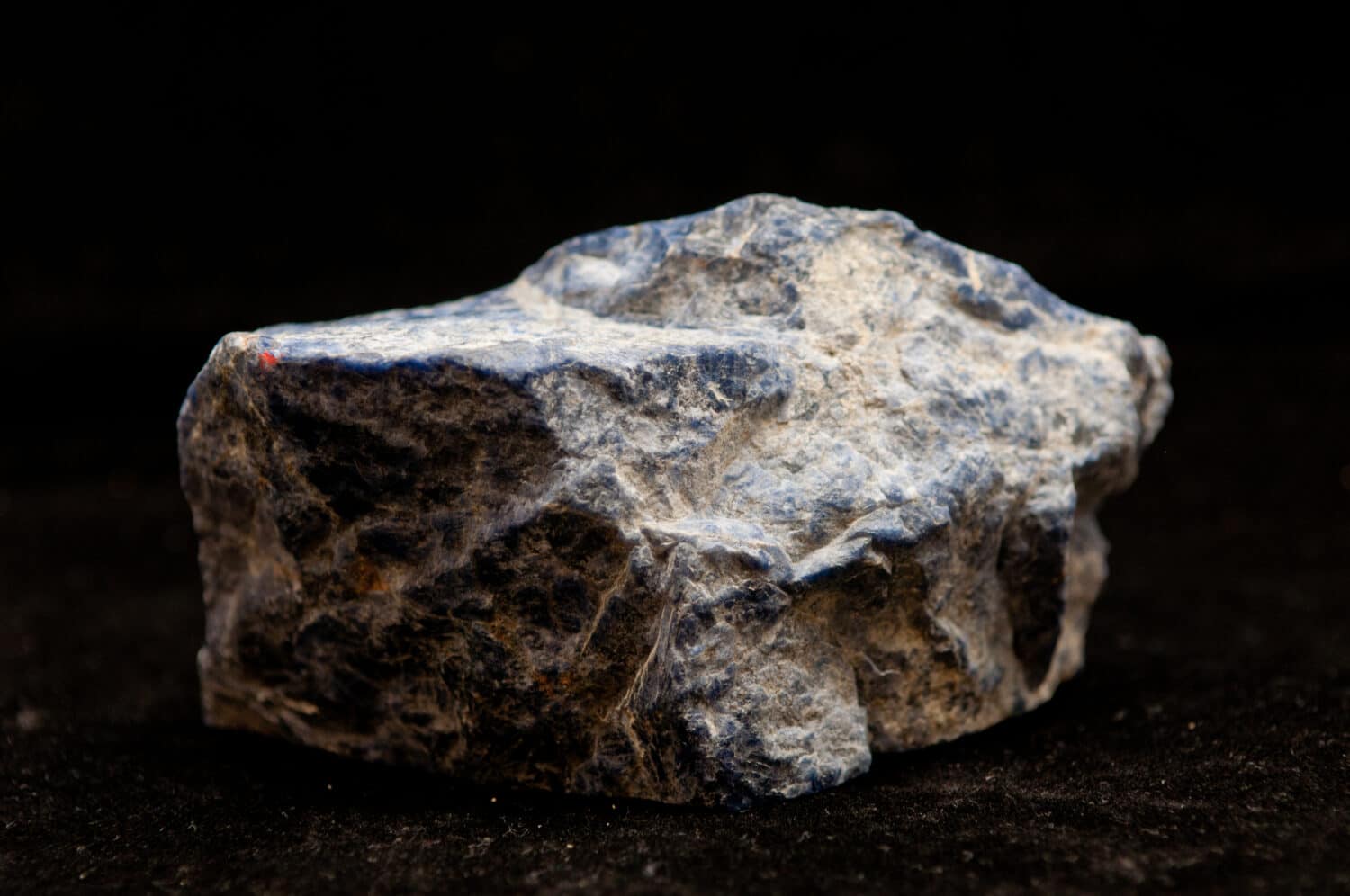
©Wirestock Creators/Shutterstock.com
Vivid blue and translucent when faceted, haüyne is part of the sodalite mineral group. Haüyne occurs in several colors, including green, gray, yellow, red, and pink. However, until recently, the only region where gem-quality crystals were blue was Germany. A few gem-quality yellow-green and blue have also been discovered in Tanzania, Afghanistan, and Myanmar.
Unfortunately, the stone has distinct cleavage, which makes it break along internal planes. It’s a characteristic that makes gem-quality faceted stones rare. When they appear in settings, haüyne typically needs a protective setting to prevent cleavage.
14. Heliodor
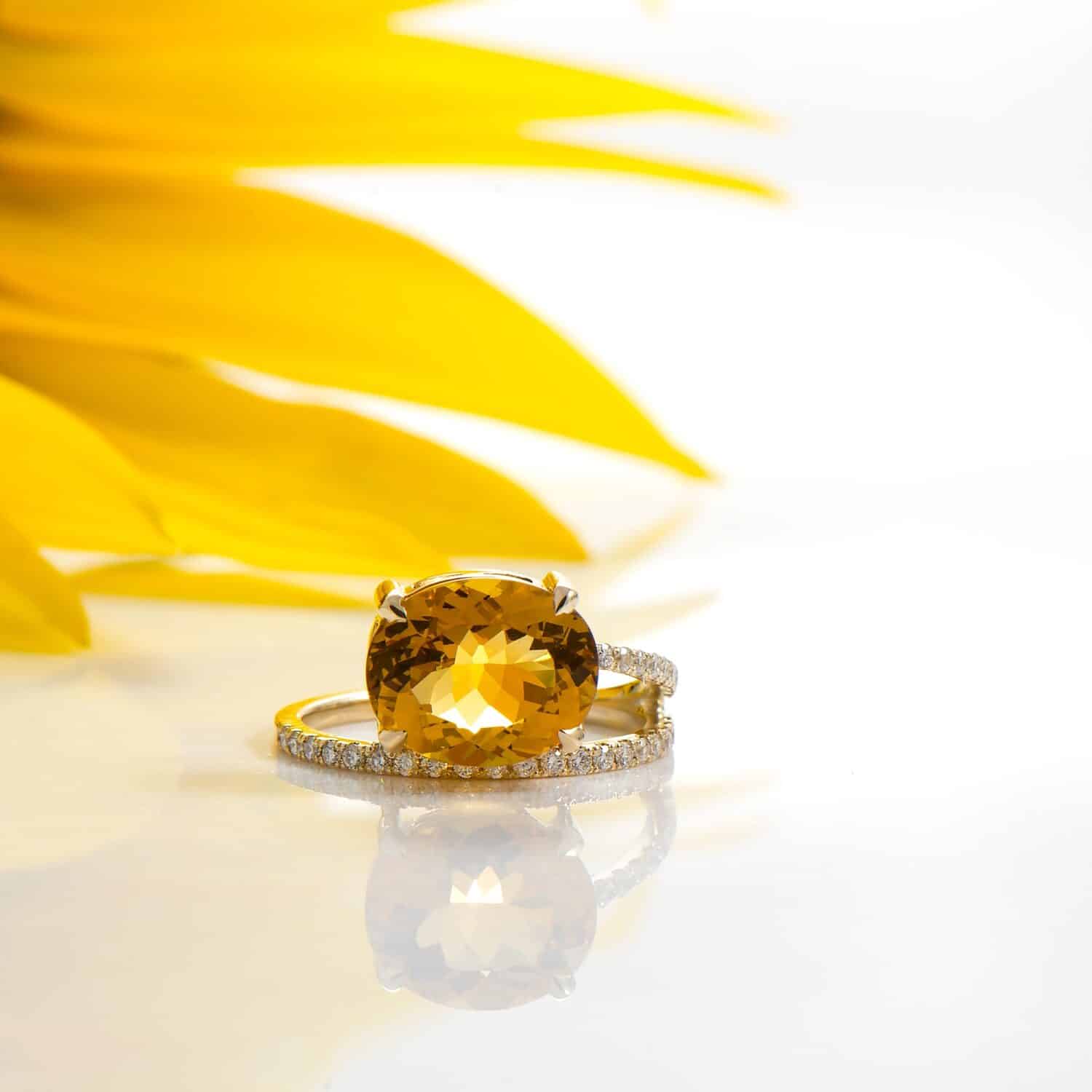
©Ioana Bica/Shutterstock.com
This beautiful gem is a beryl variety that got its trade name because of golden beryl from Namibia. However, any gem-quality golden-yellow beryl gets the trade name heliodor.
Beryl ranges from nearly colorless to black and makes fabulous jewelry. Some of the biggest and most beautiful examples are in museums.
15. Sapphire
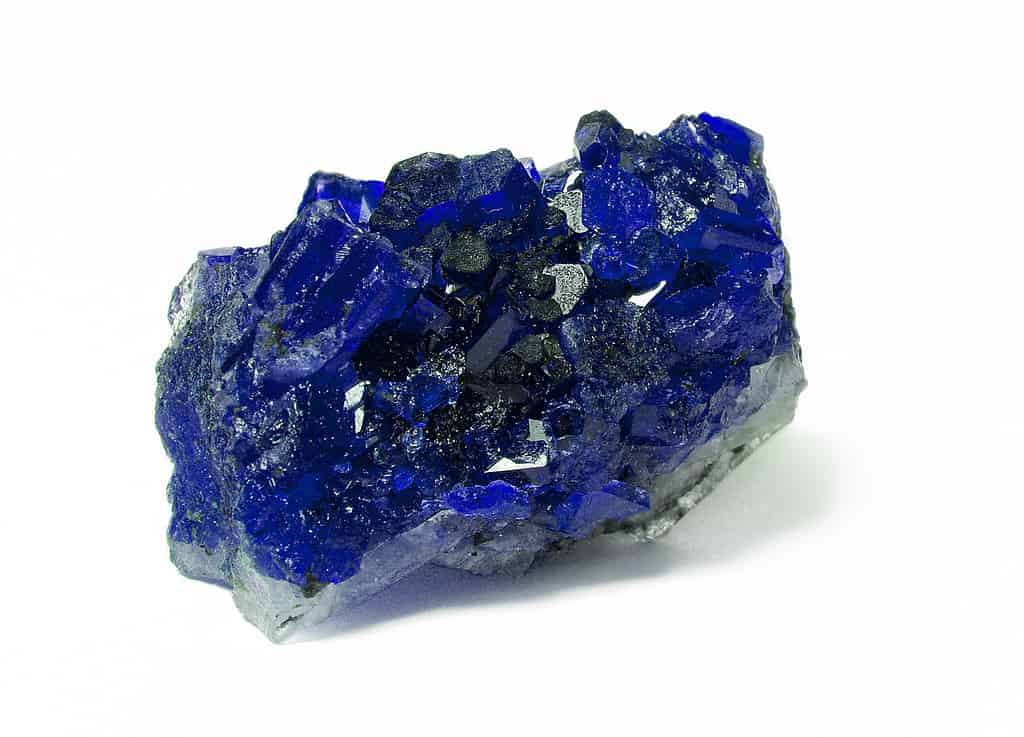
©photo-world/Shutterstock.com
The September birthstone is a beautiful blue sapphire. Although the word sapphire probably brings a brilliant blue corundum variety to mind, not all sapphires are blue. The beauty that IS sapphire can be every color except red. Corundum has a Mohs hardness of 9, placing it just behind diamonds for hardness, making it an excellent gem for jewelry!
Sapphires are mined in several regions, including Sry Lanka, Kashmir, Australia, and Montana. The famed Kashmir sapphires sometimes cost $200,000 per carat. Their blues are pure and naturally occurring, unlike others that must be heat-treated to clarify them.
Some believe that sapphire protects against poison and fraud. Thanks to its “royal” blue color, blue sapphires are traditionally associated with royalty, while star sapphires may be connected to divination.
16. Padparadscha Sapphire
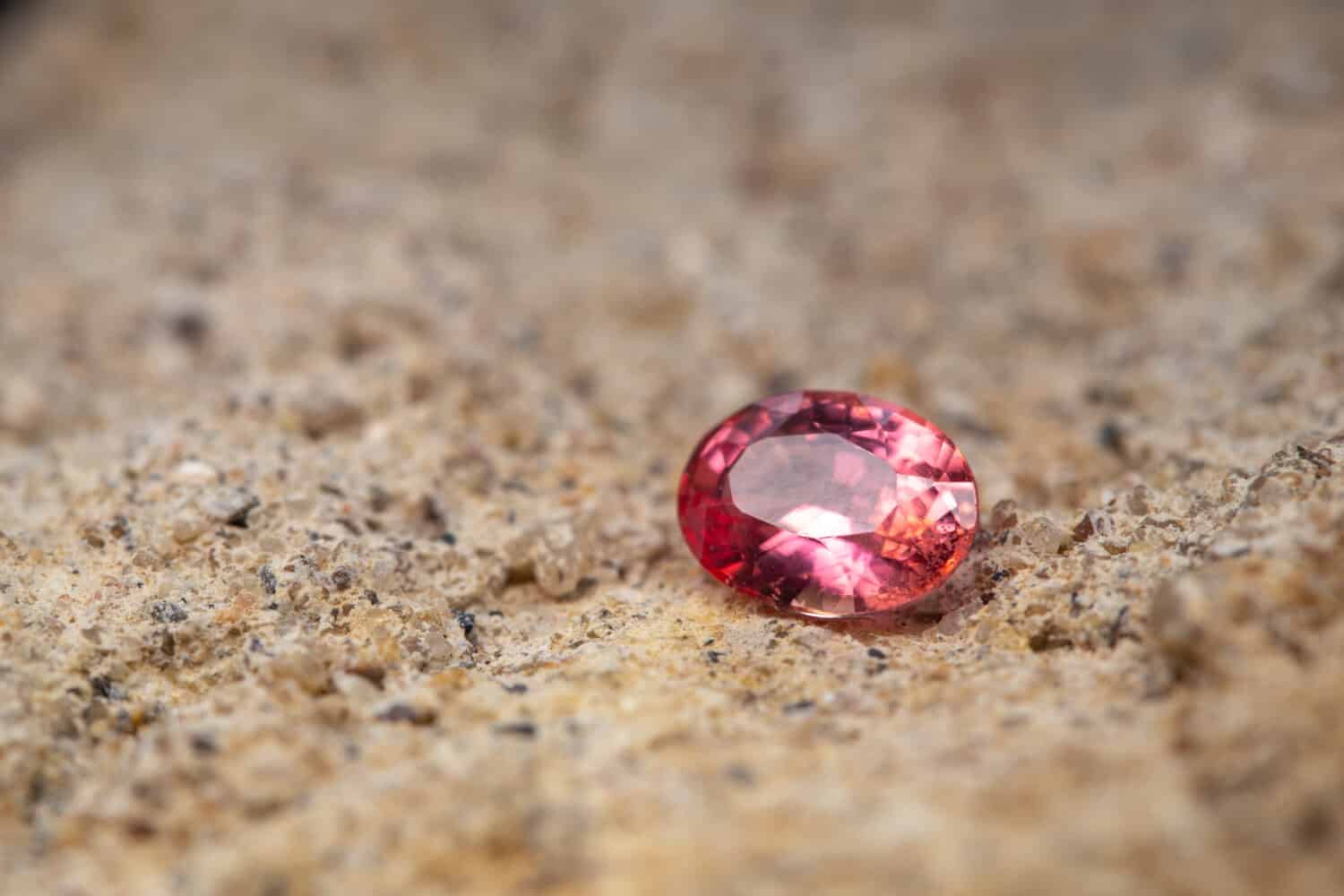
©Rajith Thiyambarawatta/Shutterstock.com
This sapphire variety is a beautiful pink-orange to orange-pink. Their “Padparadscha” moniker is after an ancient Sanskrit word that describes the color of a tropical lotus flower. This is the rarest sapphire form. Because of their rarity, natural stones are extremely expensive, and Padparadscha sapphires on the market are almost always heat-treated.
17. Ruby

©Levon Avagyan/Shutterstock.com
Closely related to sapphires, rubies are a type of corundum. They’re nearly as hard as diamonds and are always red. Additionally, rubies are heat-treated more than almost any other gem. Its red color comes from chromium traces in the crystals when they develop. However, experts don’t always agree on where to draw the red line in the stone before they decide it’s not a ruby anymore.
Historically, people have carved shapes from opaque rubies. Some even have rutile inclusions that create a star effect when carefully cut into cabochons. Additionally, cultures have associated rubies with power, wealth, and protection from illness or misfortune.
Rubies are mined in various areas, including Myanmar, Thailand, Madagascar, Mozambique, Nepal, and Afghanistan.
18. Spinel
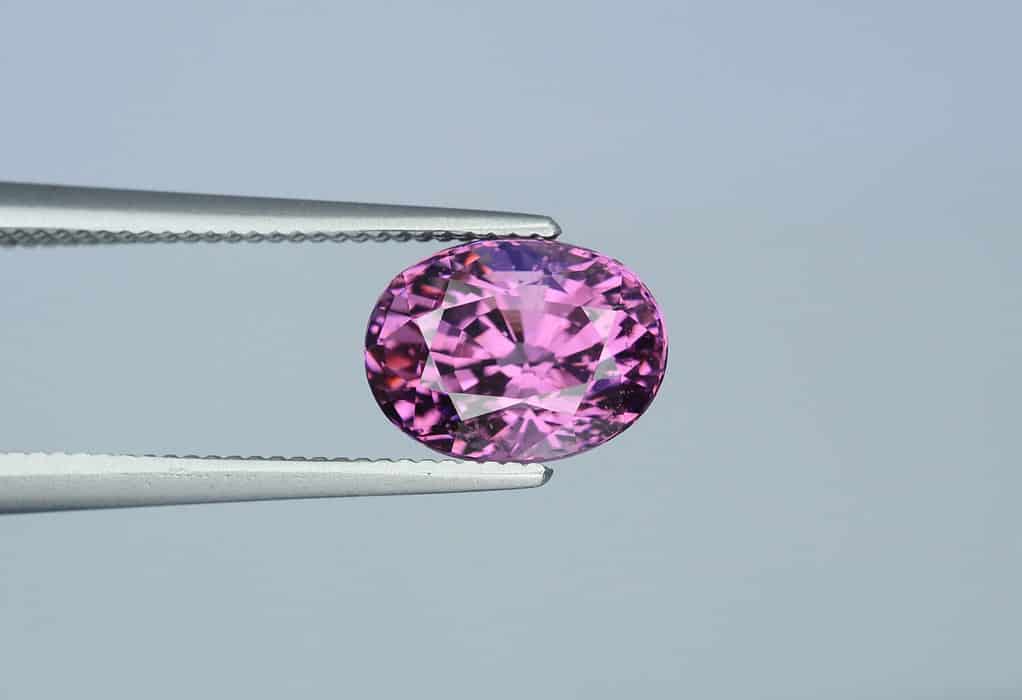
©Perfectgemstore/Shutterstock.com
With a Mohs hardness of 7.5 to 8.0, spinels are hard-wearing and terrific for jewelry. Because they have a high refractive index, well-cut spinels are gorgeous. Spinels are terrific for everyday wear and an affordable alternative to rubies, sapphires, and diamonds.
Thanks to their natural beauty, gem-quality spinels are almost all untreated, and in 2016 made it to the modern birthstone list under August. You can find spinels on every continent, including Antarctica! However, most gem-quality spinel comes from Myanmar, Afghanistan, and Sri Lanka.
19. Emerald
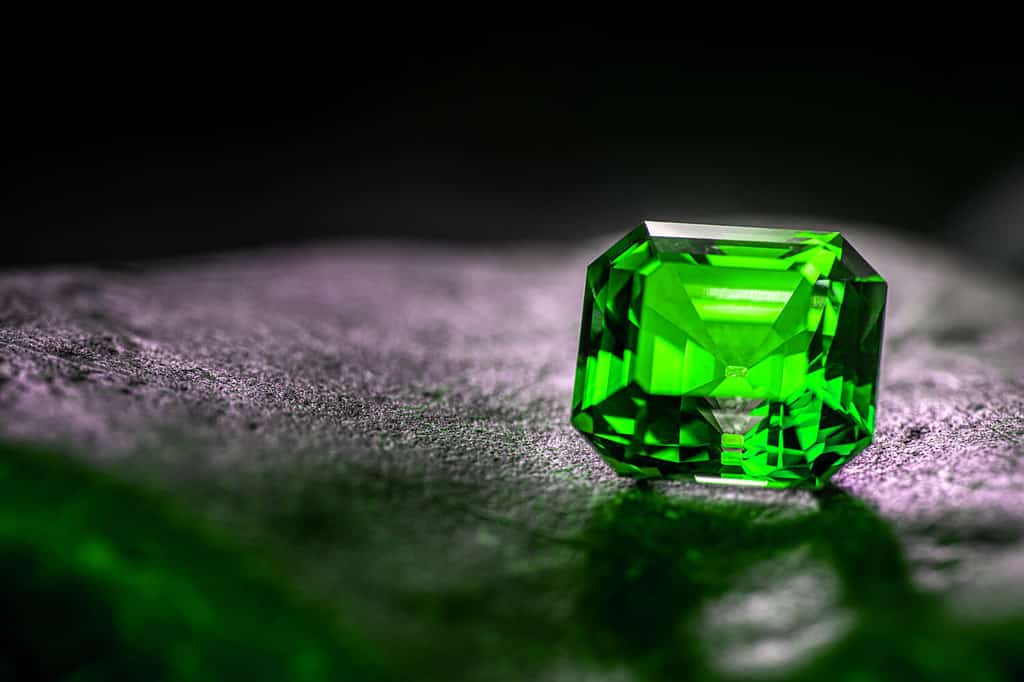
©Levon Avagyan/Shutterstock.com
Another stone associated with royalty, the emerald also symbolizes wit, foresight, and eloquence. This translucent green beryl variety can be incredibly expensive, over $100,000 per carat. Emerald’s value is tied directly to its color, but size, saturation, and hue also have a big effect on the price. May’s birthstone is also the 20th and 35th wedding anniversary stone.
Emerald’s green color comes from chromium, vanadium, or a combination of the two elements. If the color isn’t a deep enough green, they’re often called green beryls, but they’re the same stone.
20. Fluorite
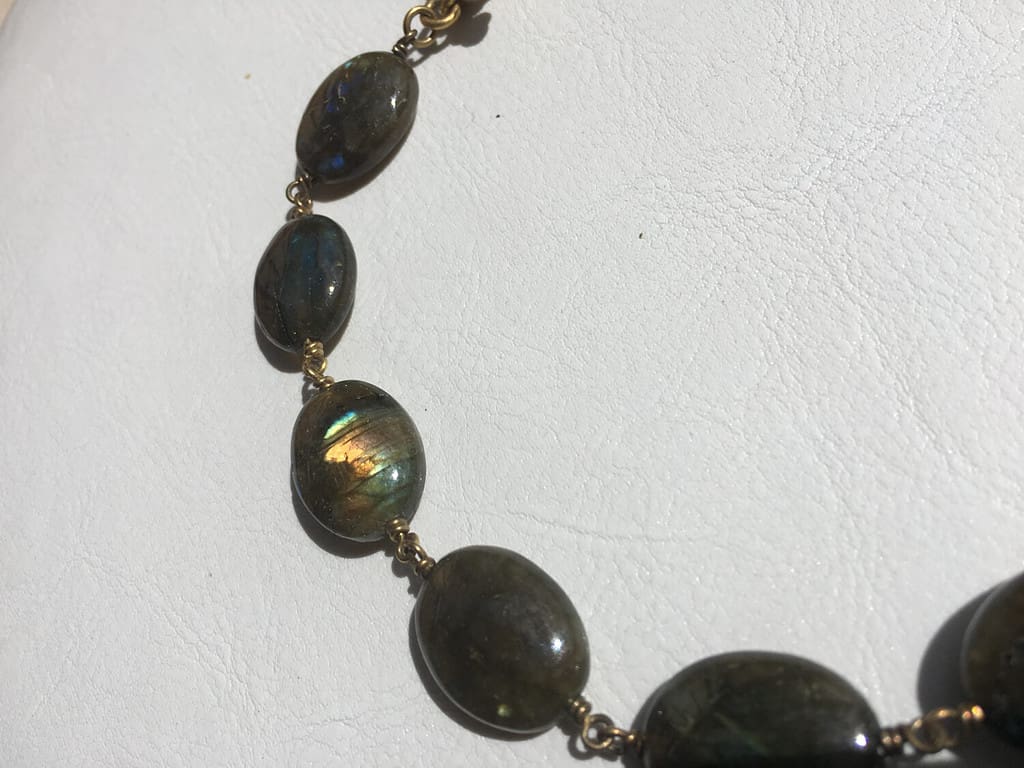
©Hello Shortcut/Shutterstock.com
If you’re a fan of iridescent, shimmery stones, fluorite may be a new favorite. It comes in many colors, including blue, green, or purple; but a few rare stones can be chrome green or pink.
It’s relatively fragile, so most of it isn’t suitable for hard-wearing jewelry, but its beauty still tempts people! Despite its fragility, people cut fluorite into faceted stones. However, its best use in jewelry is as polished cabochons and beads.
21. Garnet

©Aleksey Konstantinovich/Shutterstock.com
While the most common color for the January birthstone is red, garnet comes in many colors. Where minerals like corundum or beryl are a single species colored with trace elements, garnets are different species and almost never purely one species or another.
The most common garnet family gemstone is the almandine garnet. They come in many colors but are most often the dark red variety you associate with garnets.
22. Andradite

©Breck P. Kent/Shutterstock.com
This is one of the rarest garnets and the best specimens have more fire than diamonds. Demantoid garnet is a type of andradite that exhibits a gorgeous, grass green in some specimens.
23. Kunzite

©cvalle/Shutterstock.com
Kunzite is a variety of spodumene. It comes in a range of pinks to violet-purple and some people use it as a February birthstone. It’s a softer stone that fractures more easily, with a Mohs hardness of 6.5 to 7.0. However, even though it’s difficult to cut, kunzite makes a beautiful piece of jewelry.
It doesn’t have the long history and mythology associated with gems like diamonds, because it was only discovered in 1902. George Frederick Kunz was able to confirm several pink crystals found in San Diego County, California, were a previously unknown spodumene variety.
24. Lapis Lazuli
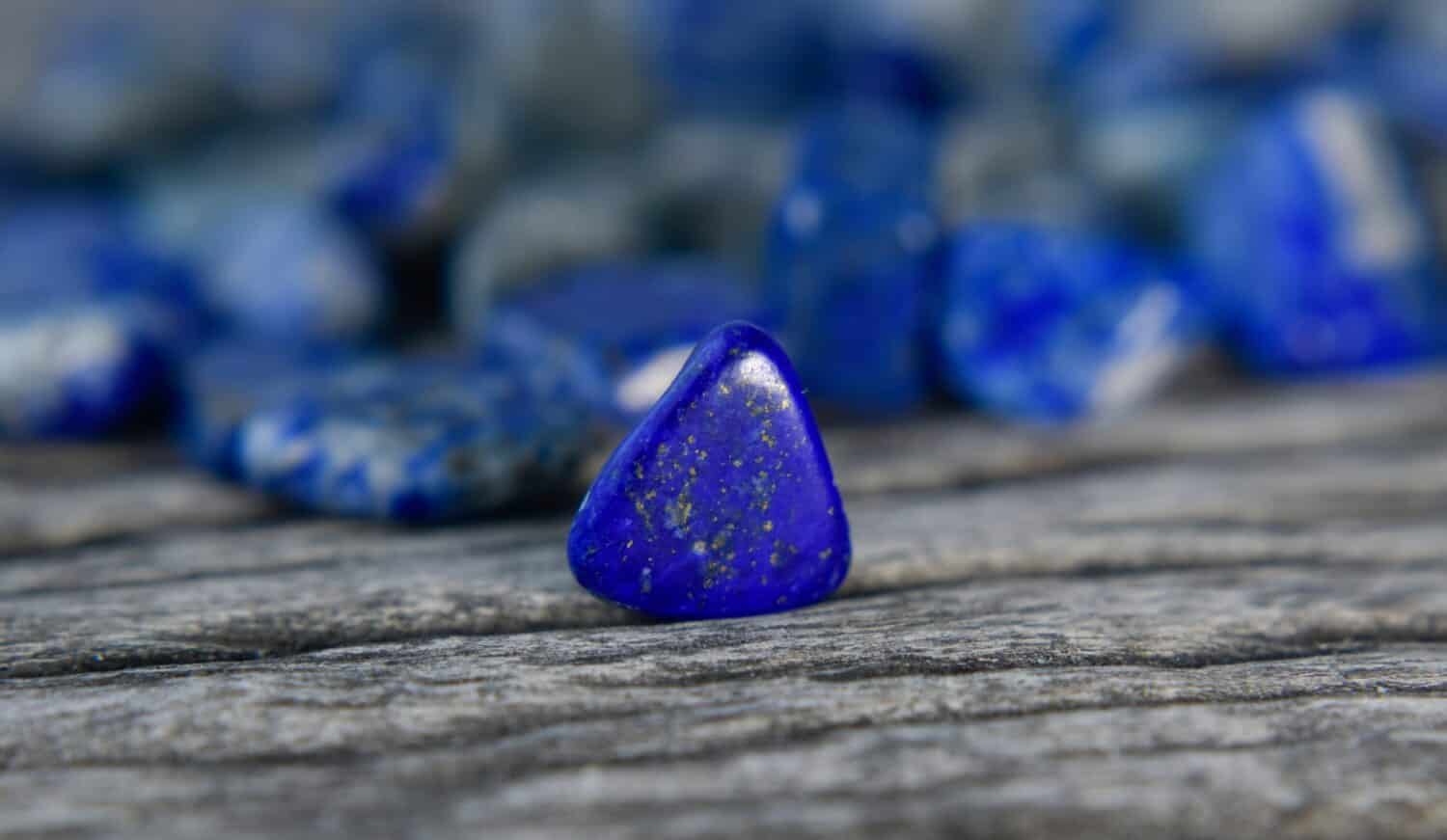
©Pesh Siri/Shutterstock.com
Lapis lazuli, often simply called lapis, has been popular for thousands of years. Many of these stones remind people of the planet Earth — with its blues sometimes swirled with white.
As one of the traditional birthstones for December, many scholars believe that early references to sapphire may have referred to lapis lazuli. Myths and legends surrounding lapis lazuli are some of the oldest. The story of the Sumerian goddess of love, Inanna includes lapis lazuli jewelry as symbols of her rank. Possibly because of this, people associate lapis with royalty and deities.
Used for everything from jewelry to carvings and pigment, archaeologists have found it at many dig sites. Some of them dated to 6,000 BCE. Lapis lazuli often has flecks of golden pyrite that flash in the sun.
25. Malachite
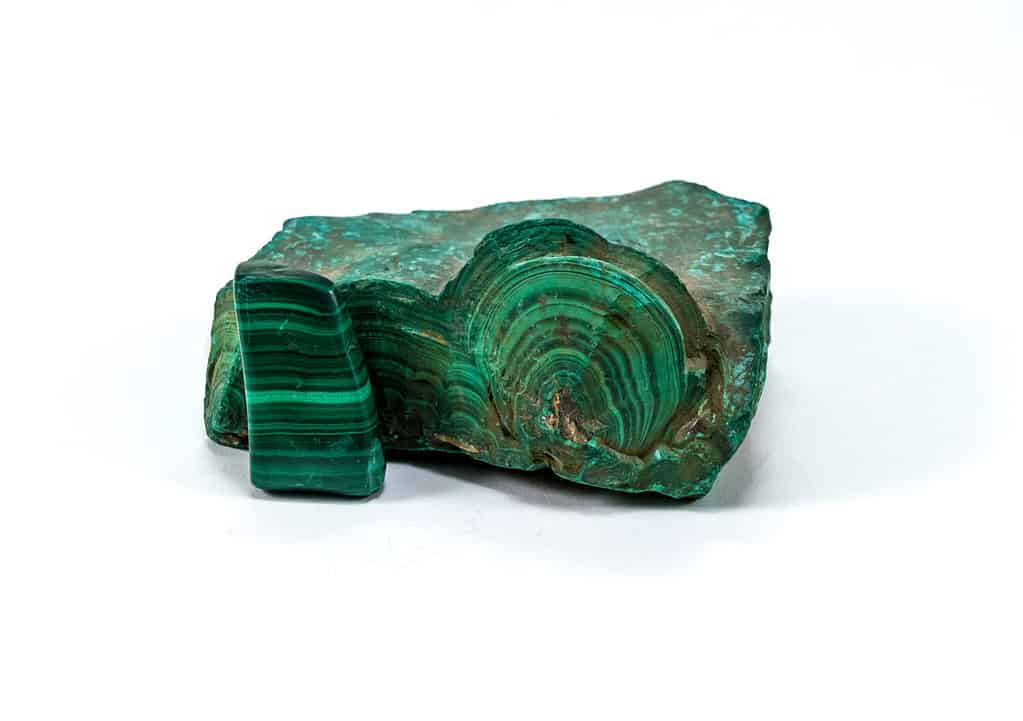
©CJK CREATIVE/Shutterstock.com
The creamy green shades visible in malachite and its relative softness make it a wonderful stone for carving — plus it takes a polish pretty well! Malachite is always found near copper deposits.
Like lapis lazuli, people have mined malachite for thousands of years. Although dust released from grinding malachite is toxic, it’s been used as a paint pigment.
26. Moonstone

©KrimKate/Shutterstock.com
June has a wonderful alternate birthstone in this one! Moonstone varies from blue to white shades, and even though it can be fragile, is amazing in jewelry.
These lovely gems have inspired beliefs that they support fertility, enhance or attract love, and the obvious associations with the moon and moonlight.
27. Pearl

©Tish1/Shutterstock.com
No matter whether a pearl came from a freshwater or a saltwater mollusk, it is a thing of beauty. Even though a few types of gems, like amber, originate in plant matter, pearls are the only gems that grow within living creatures.
Historically, people found pearls in the wild. However, these days, most pearls are cultivated. The traditional June birthstone comes in several colors, including black, white, red, blue, purple, yellowish, and green. Anything other than black and white are usually freshwater pearls, but saltwater pearls can sometimes come up with a few interesting colors too!
Some say that white pearls are the gods’ tears; they’re also associated with the moon and the goddess of love, Venus.
28. Peridot
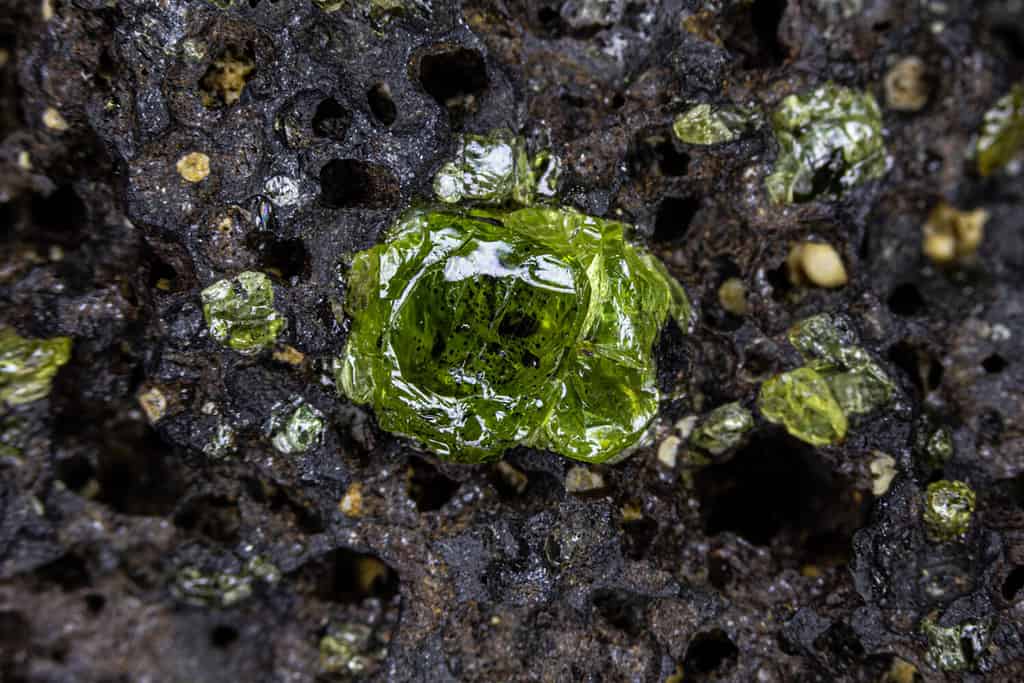
©David G Hayes/Shutterstock.com
Peridot is always green, but the particular shade of green varies, depending on where it was mined. Similar to quartz, peridot ranges in hardness from 6.5 to 7.0. Peridot is more delicate and should always be placed in protective settings; even the sweat from your skin can contain particles that may scratch the stone.
Supposedly a favorite of Cleopatra, people still use peridot as a protective stone that wards off evil spirits and invites prosperity, abundance, and happiness into the home.
29. Rose Quartz
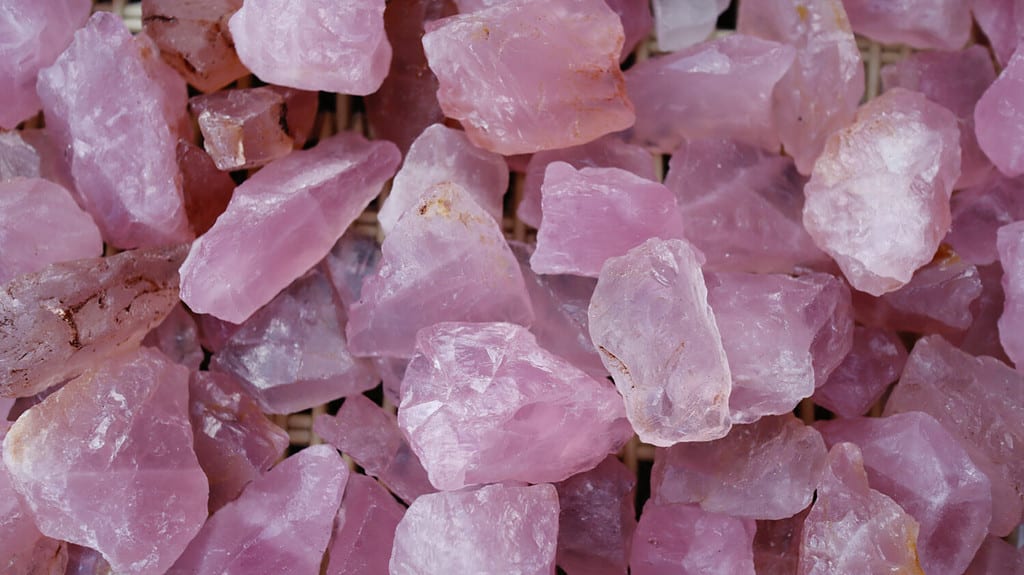
©Pranisa Thanatattanon/Shutterstock.com
This pink version of quartz gets its color from fibrous inclusions. The inclusions are composed of a mineral similar to dumortierite — a metamorphic stone that makes beautiful cabochons.
Rose quartz has a hardness of 7.0 and no cleavage, which makes it a great stone for jewelry. Because of its milky opaque to translucent nature, it isn’t faceted often but is perfect for beads, decorative objects, and cabochons.
The pink color gives it associations with love and other matters of the heart. It can also make a great stone for an engagement ring.
30. Sunstone
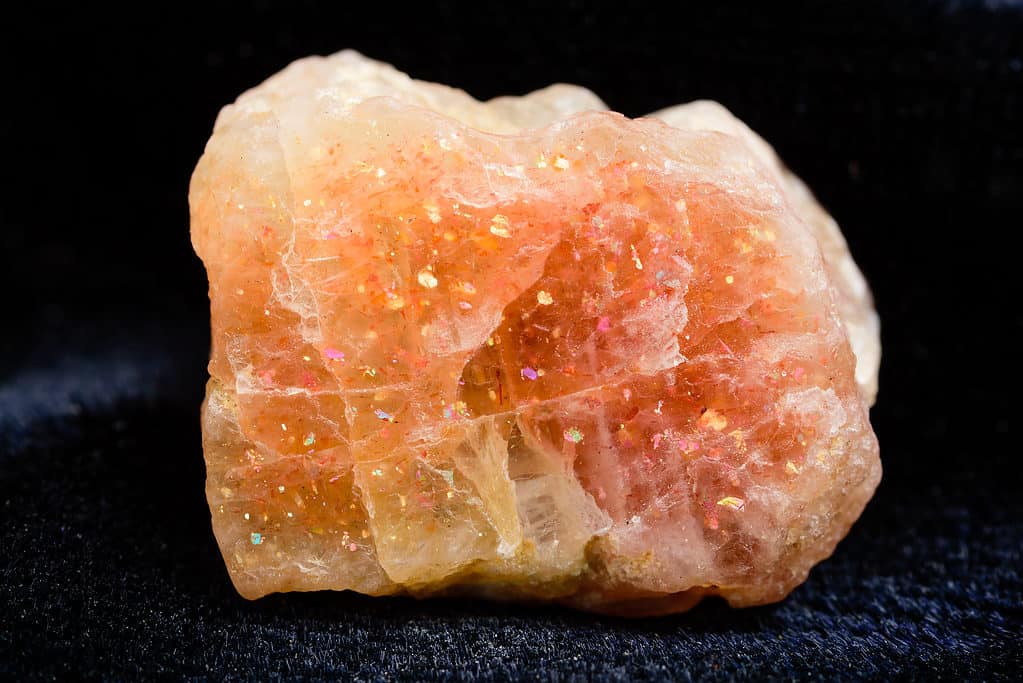
©Imfoto/Shutterstock.com
Sunstone comes in yellow, red, peachy, and green colors with goethite or hematite inclusions. The inclusions look like little specks of light when the sun hits it — this stone is lovely!
Most sunstones work best as cabochons, it doesn’t facet well and isn’t translucent enough to warrant trying it. Some cultures believe it has healing properties and many people use it in jewelry or meditation to bring joy and abundance.
31. Tanzanite
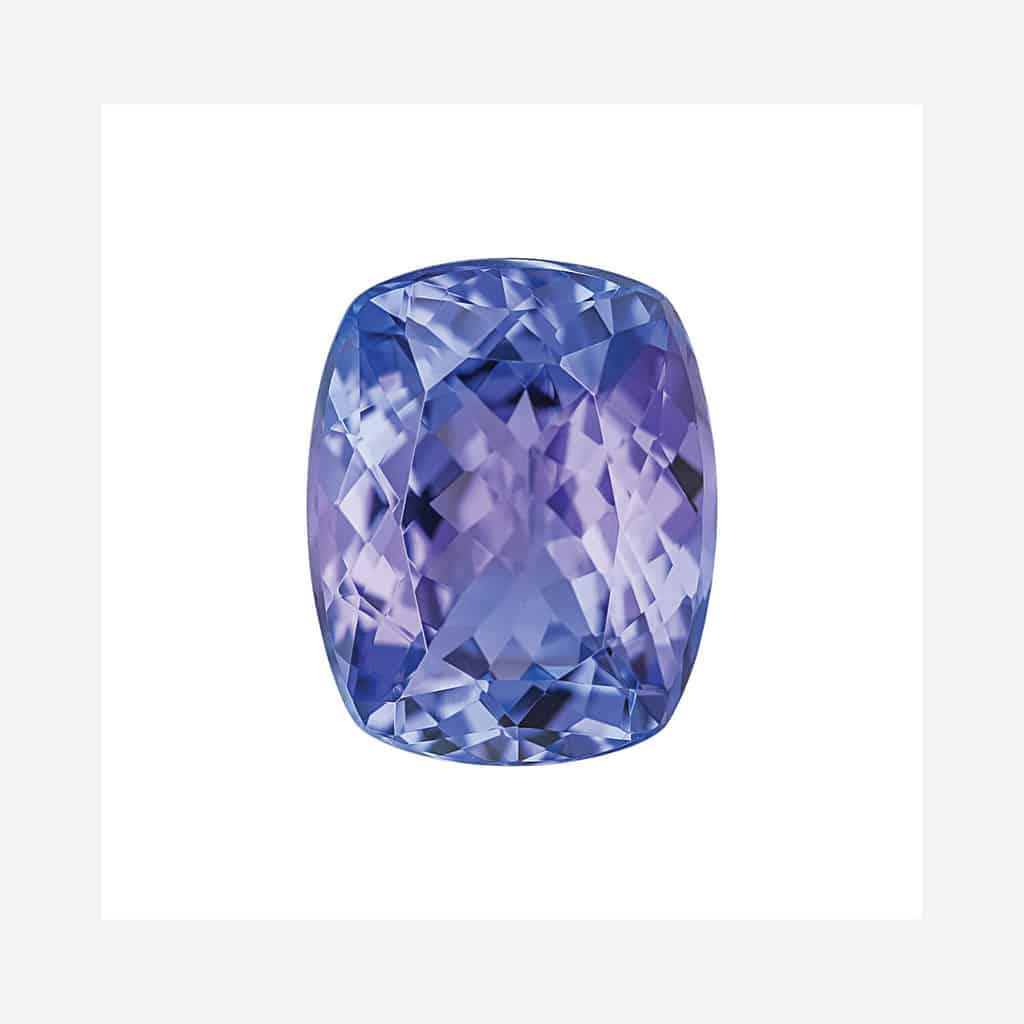
©AllaboutDesign/Shutterstock.com
Here’s a stone where heat treatments are necessary to achieve the color you see above. In its natural state, it’s reddish brown. However, this transparent zoisite variety becomes a stunning blue-to-violet color after heat treating it — and it’s stable!
It’s exceedingly rare to find an untreated blue-violet tanzanite. So rare, that experts say you should always assume blue-violet tanzanites were heat treated.
32. Green Zoisite
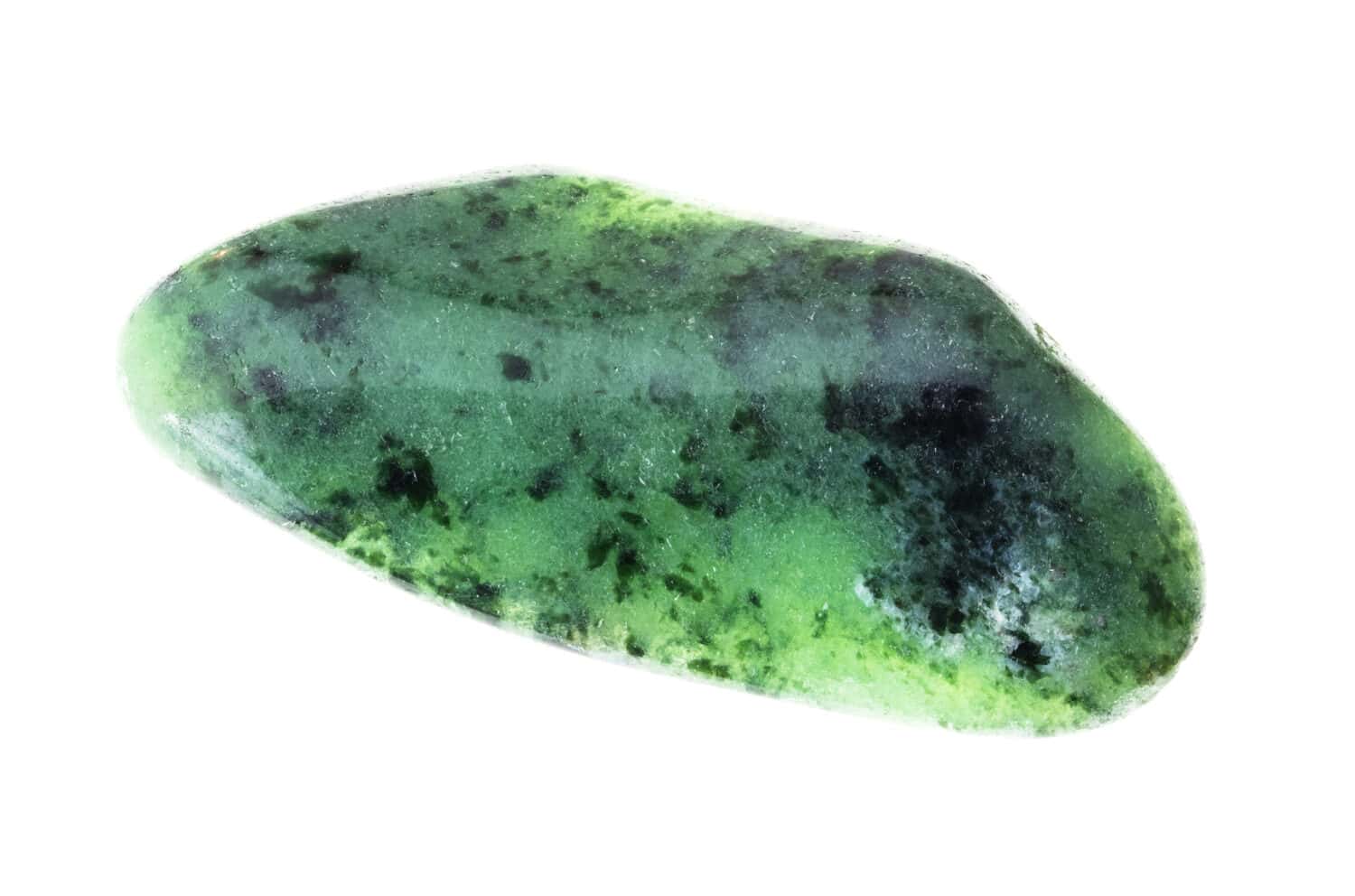
©KrimKate/Shutterstock.com
Green zoisite is rare and prized. It’s the same species as tanzanite, just with a different element causing the color. Zoisite is a lovely green color that varies according to location.
33. Topaz
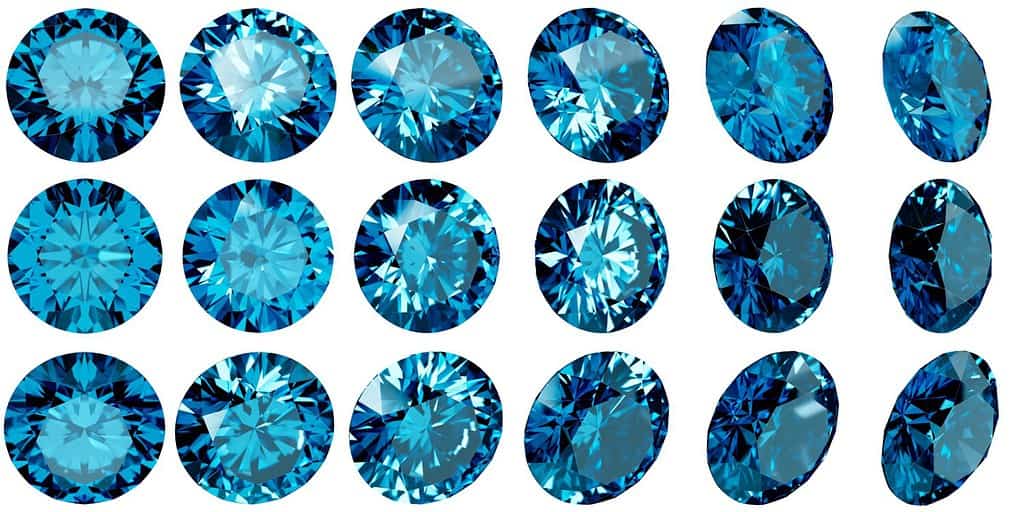
©MyArtSTD/Shutterstock.com
While you may only be familiar with blue topaz, the gem comes in several colors, including red, pink, golden orange, and colorless. However, the most common are blue and golden yellow.
Interestingly, many blue topaz stones were treated with a two-step process that changed it from colorless, to brown, then blue. The process is so similar to what happens naturally that you can’t tell whether it was treated or natural. Topaz is the traditional birthstone for November and symbolizes wealth, health, and astrology.
34. Tourmaline
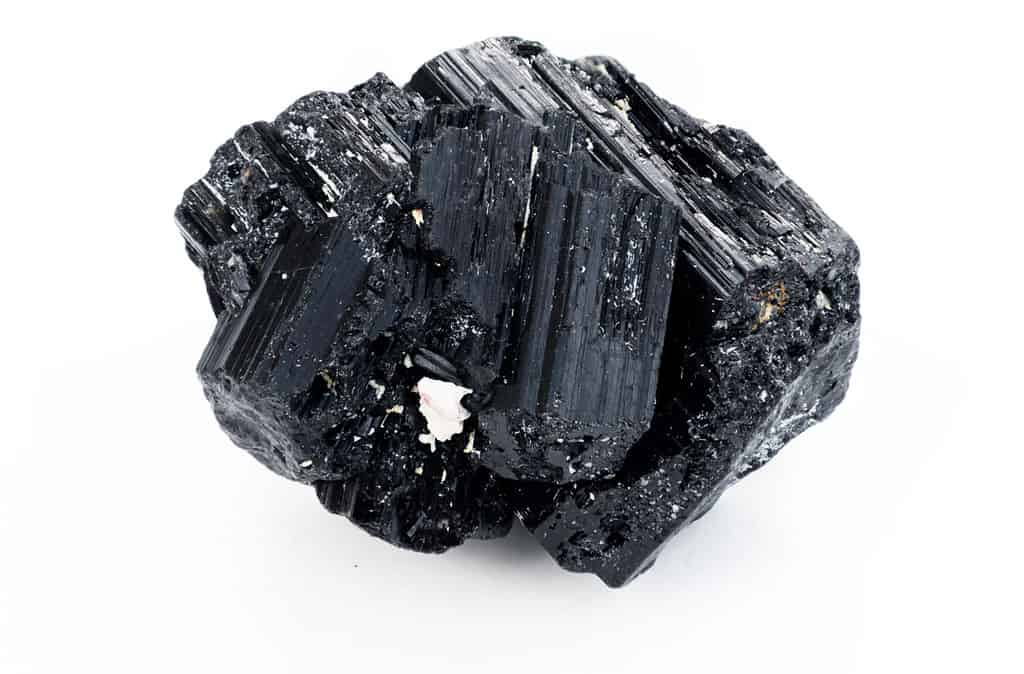
©michal812/Shutterstock.com
Tourmaline is a group of several groups, subgroups, and many species. As we discover more types of tourmaline, the list grows. One thing all tourmalines have in common is they have hexagonal crystals — but that’s where the commonalities end.
Some tourmalines are transparent and facet well, while others fracture. The color selections are endless. Depending on the color, tourmaline is often associated with different Chakras, and in general, helps relieve stress.
35. Turquoise

©AkulininaOlga/Shutterstock.com
Blue to blue-green turquoise brightens up nearly every setting. It’s been used and loved by various cultures for over 5,000 years, but the traditional December birthstone is probably best known for its use in Native American jewelry.
It’s a pretty soft stone, related to malachite. Many believe that it protects the wearer from injuries and falls, and Aztecs valued it even more than the Spaniards valued gold.
36. Zircon
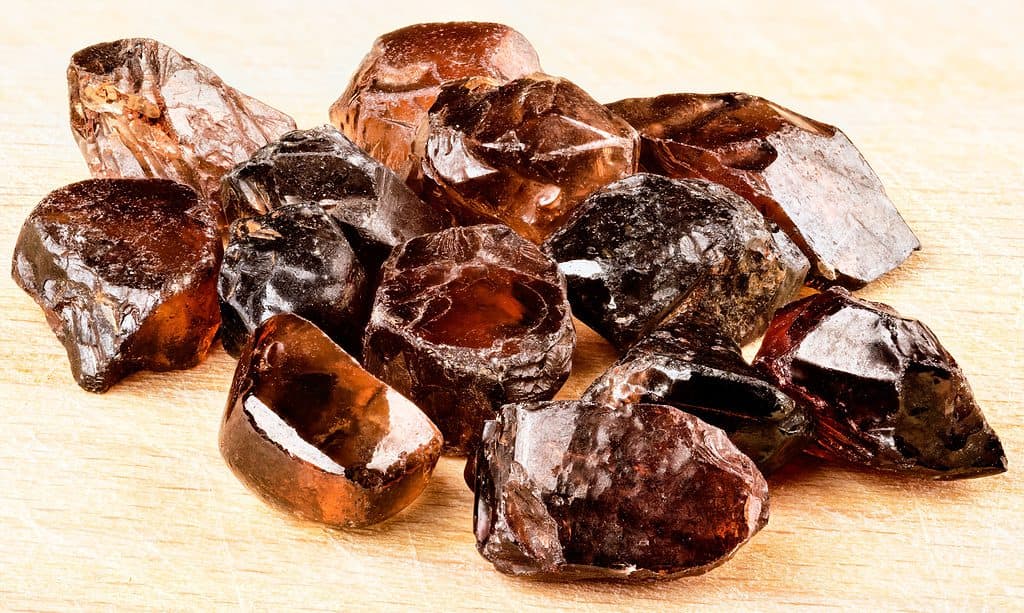
©iStock.com/Reimphoto
This naturally occurring mineral comes in many colors, including green, blue, pink, orange, colorless, and yellow. Even though it is more rare than diamonds, colorless zircon has been used as a diamond substitute. However, don’t confuse zircon with cubic zirconia — they are entirely different gems!
Zircon is a more fragile gem and needs protective settings to prevent damage. Regardless, it’s a beautiful stone. Golden-yellow zircon invites prosperity, while red chases off evil spirits. In the end, different cultures and people interpret zircon differently, depending on the color.
37. Diamond
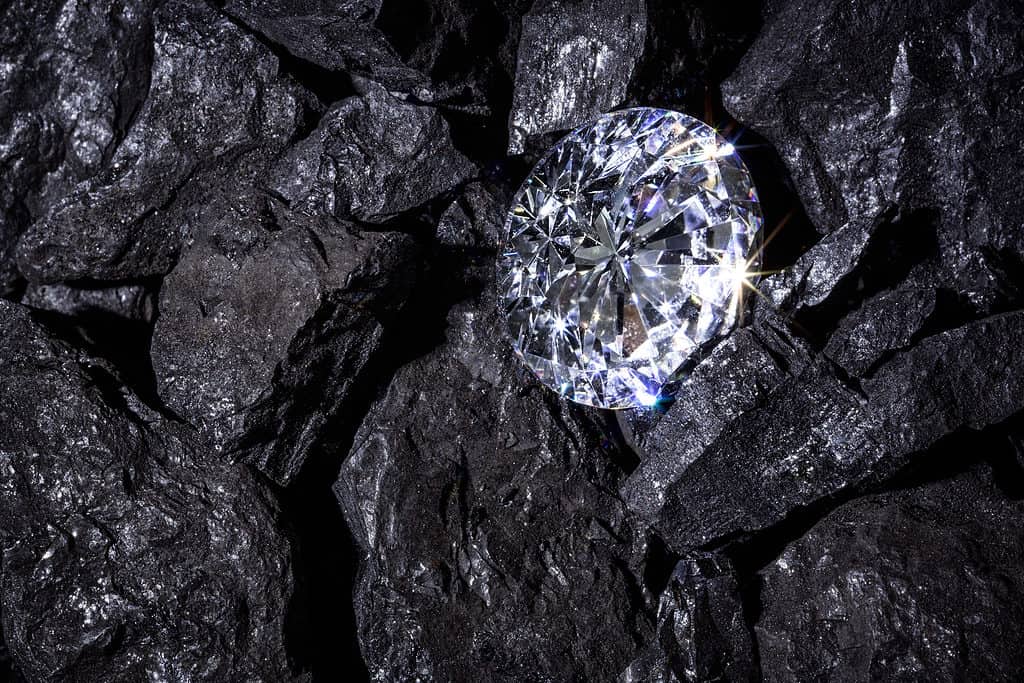
©RTimages/Shutterstock.com
So after all of these types of gems, are diamonds really a girl’s best friend? Maybe, but maybe not. The April birthstone comes in different colors, but all diamonds form under immense pressure and high temperatures only found 100 miles below the earth’s surface.
They come in several colors, including pink, colorless, yellow, and black — some colors are more expensive and rare than others. Although perfect specimens are rare, diamonds themselves aren’t. They’re mined in South Africa, India, Brazil, and a few other locations worldwide.
Diamonds are one of the hardest materials known to humanity and can cut other materials. They’ve been worn as jewelry and believed to impart protection during warfare.
38. Opal
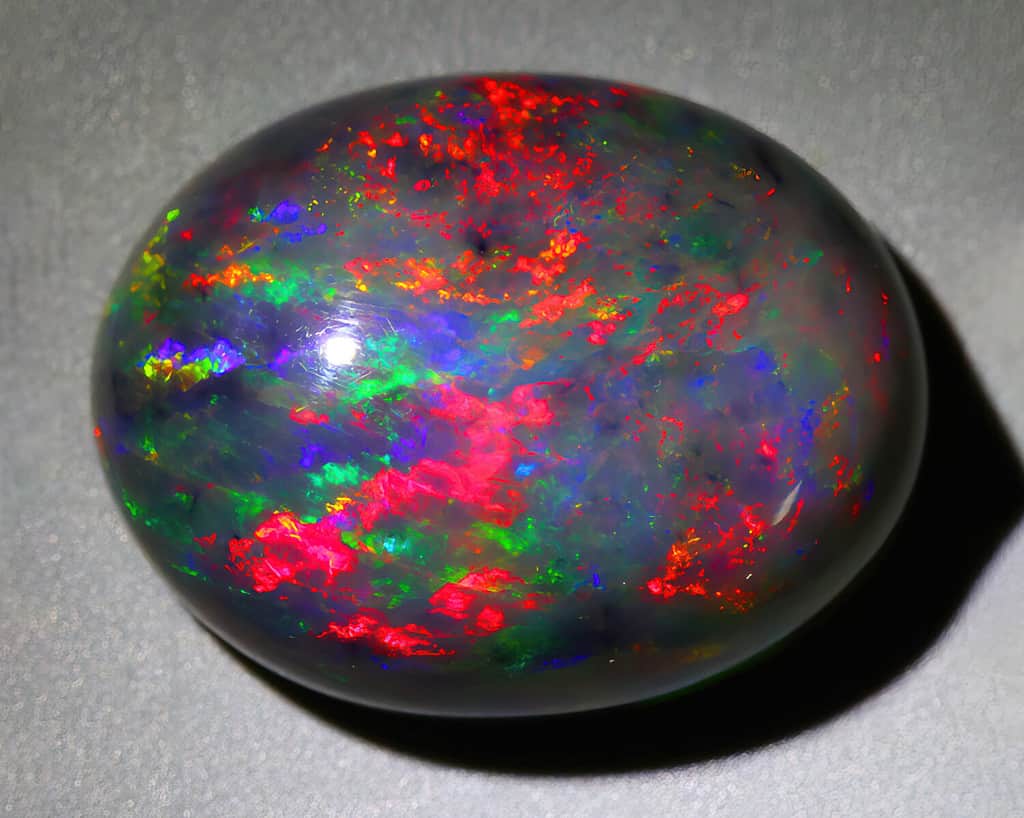
©galka3250/Shutterstock.com
One of October’s birthstones, opal is unique among gemstones. It’s not a crystalline structure, but a form of hydrated silica. It forms when water works its way into cracks in the ground, dissolving quartz sand. When that happens, it becomes a silicic acid solution that fills in those cracks and solidifies over time — becoming opal.
To many people, opal is a symbol of hope and purity. Because opal has all of the rainbow’s colors, Romans believed it was a combination of several stones the gods fused together — such as topaz, sapphire, and chrysolite.
39. Ametrine
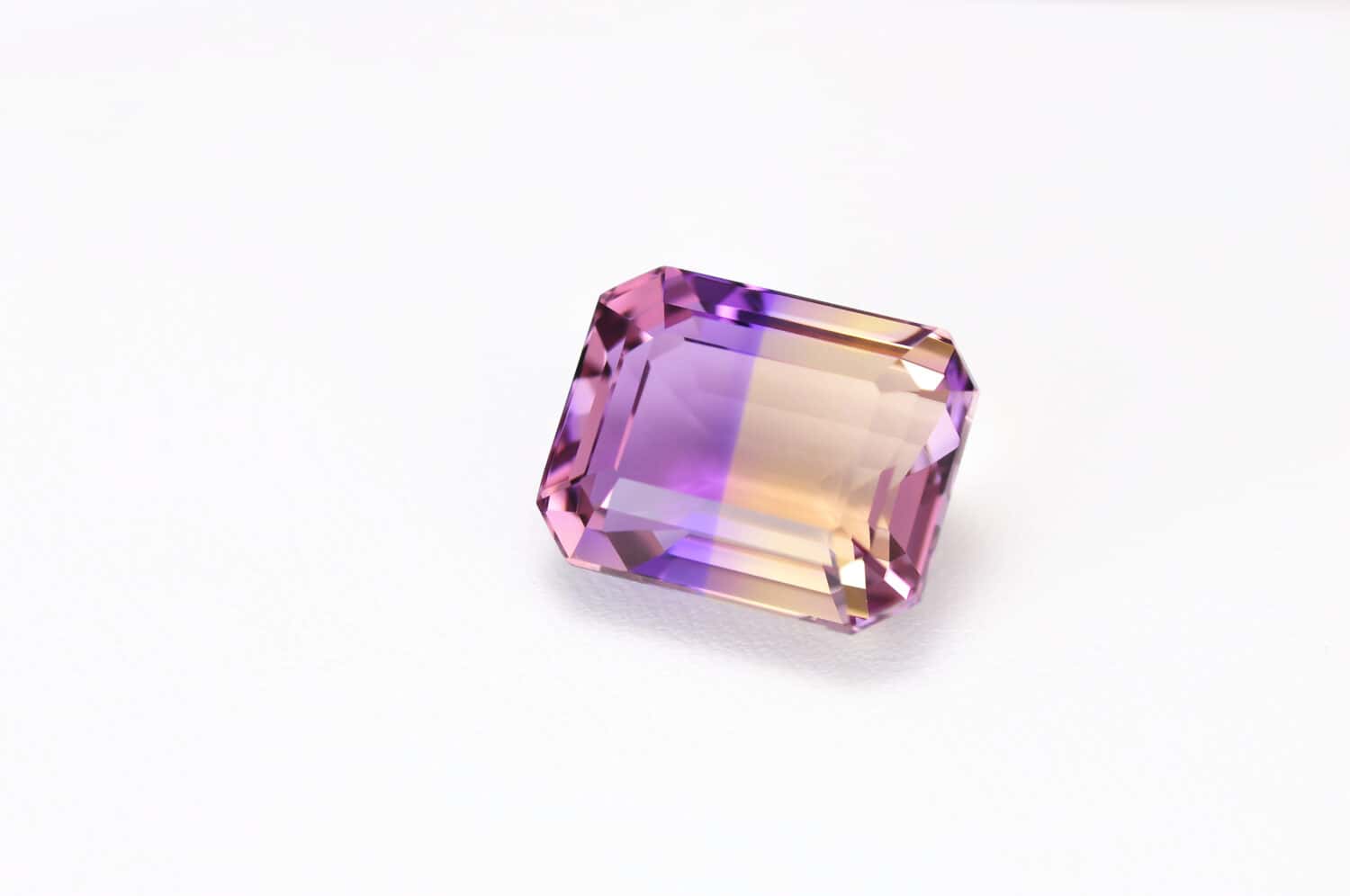
©Finesell/Shutterstock.com
This quartz variety blends both amethyst and citrine together in one stone. It’s relatively rare, and you’ll only find gem-quality ametrine in a single Bolivian location. However, since ametrine crystals are often fairly large and clean, the price per carat stays consistent, no matter the stone’s size.
For many people, ametrine symbolizes balance and harmony — bringing the chakras into balance. Some believe it has healing properties and the more evenly balanced the amethyst and citrine are within the stone, the more powerful the stone.
40. Cinnabar
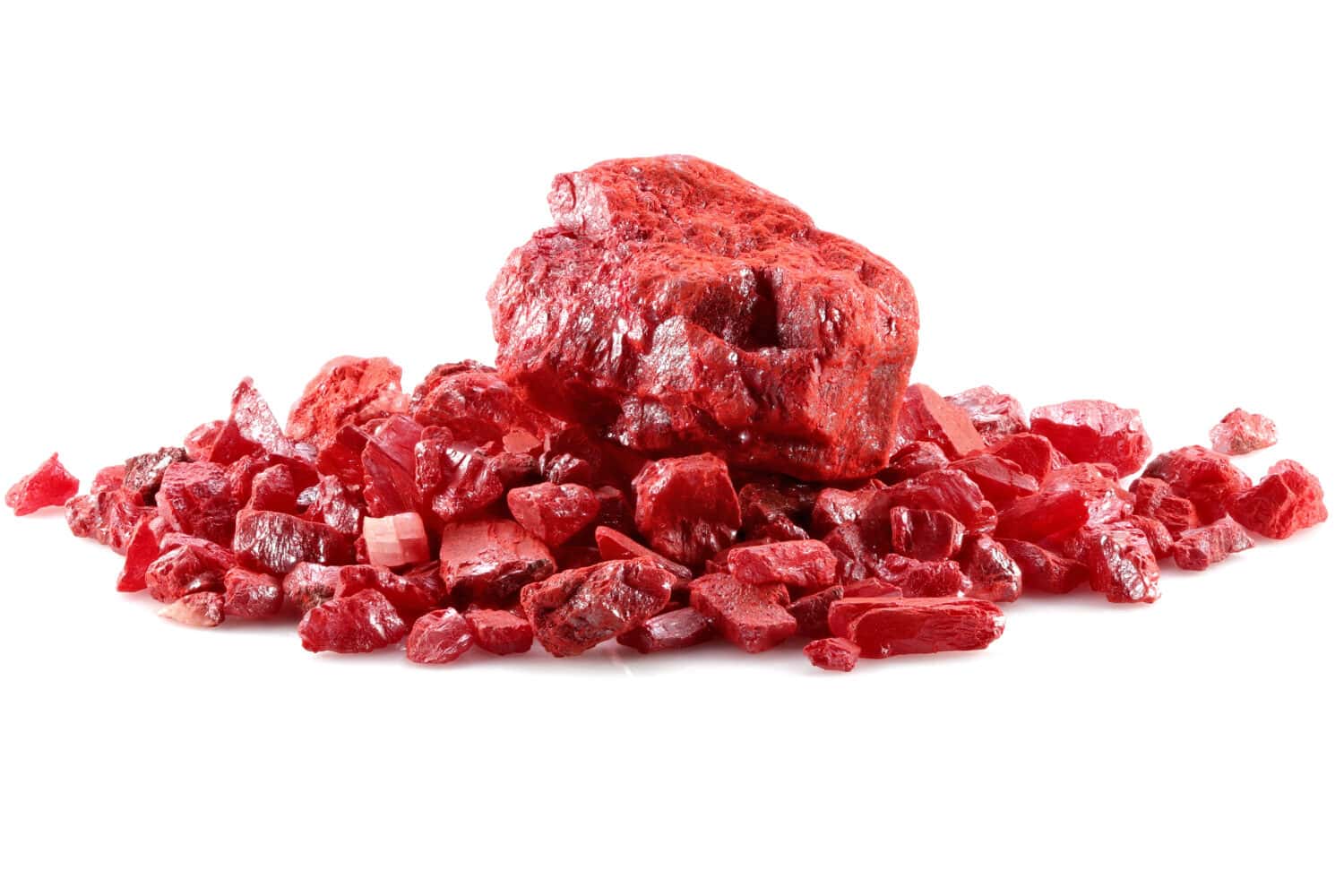
©Bjoern Wylezich/Shutterstock.com
This soft stone is also fragile. How soft? Its Mohs hardness is 2.0! Although beautiful, cinnabar isn’t used for jewelry often. Sometimes, people cut it into beads, but most often they carve it into various designs.
However working with cinnabar isn’t without danger, cinnabar contains mercury. So don’t inhale any dust or fumes if you work with it.
41. Cobaltite
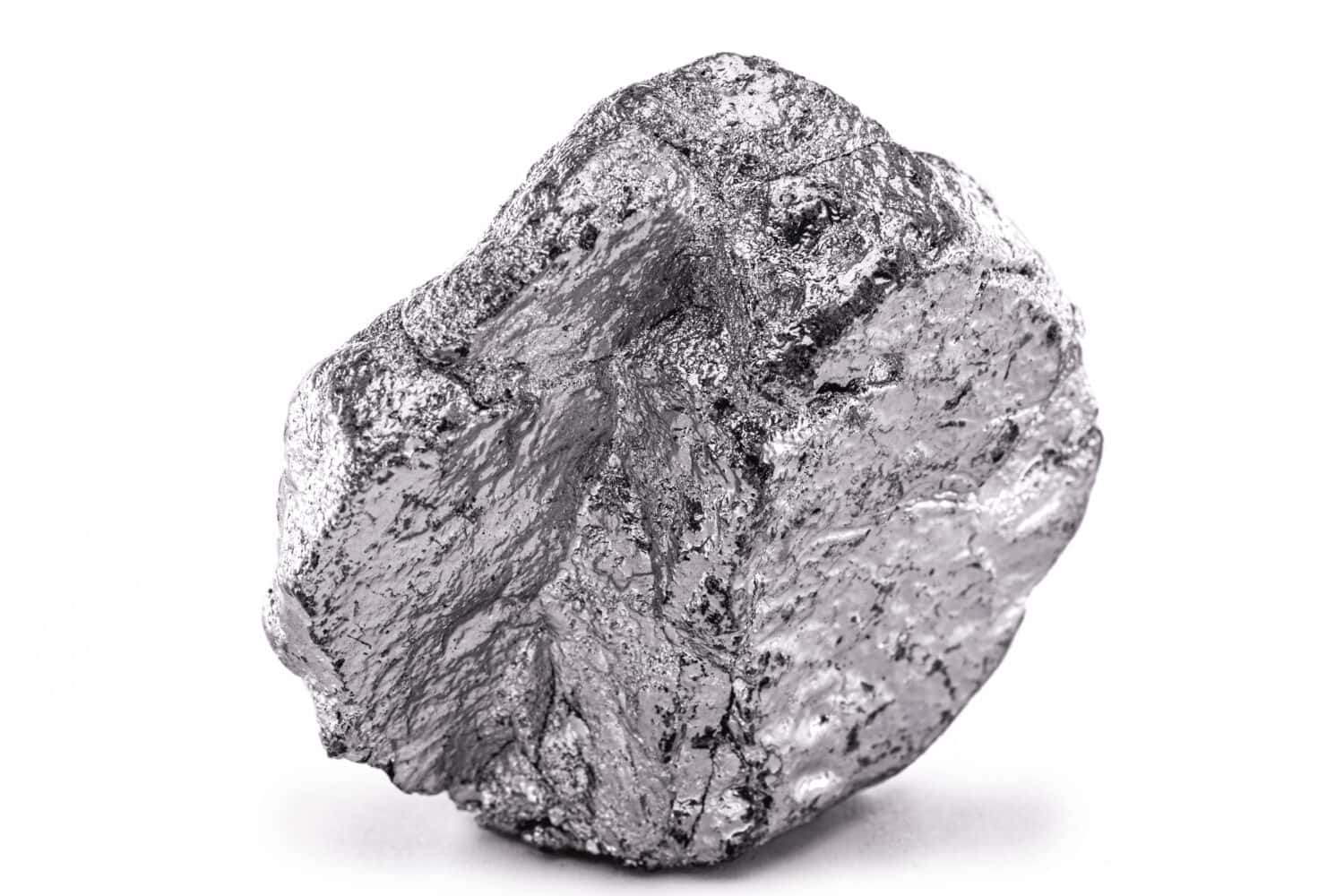
©RHJPhtotos/Shutterstock.com
This rare sulfide mineral is a source of cobalt. There are only a few sources for this rare mineral, including California, Colorado, Western Australia, Germany, and India.
Cobaltite contains arsenic and cobalt, so anyone who works with it must take precautions. Grinding cobaltite for any jewelry releases particles that can cause health problems. But its shiny, metallic sheen is beautiful!
42. Coral

©RP designs/Shutterstock.com
Coral is another interesting gem. It’s not truly a stone, because it’s the exoskeleton of a tiny, plant-like marine animal. This gem makes a wonderful carving medium and gorgeous beads.
This naturally occurring gem has a long history in jewelry and carving. Coral’s spiritual uses include protective amulets for moms and babies, increasing self-esteem, and overcoming fear.
43. Crocoite
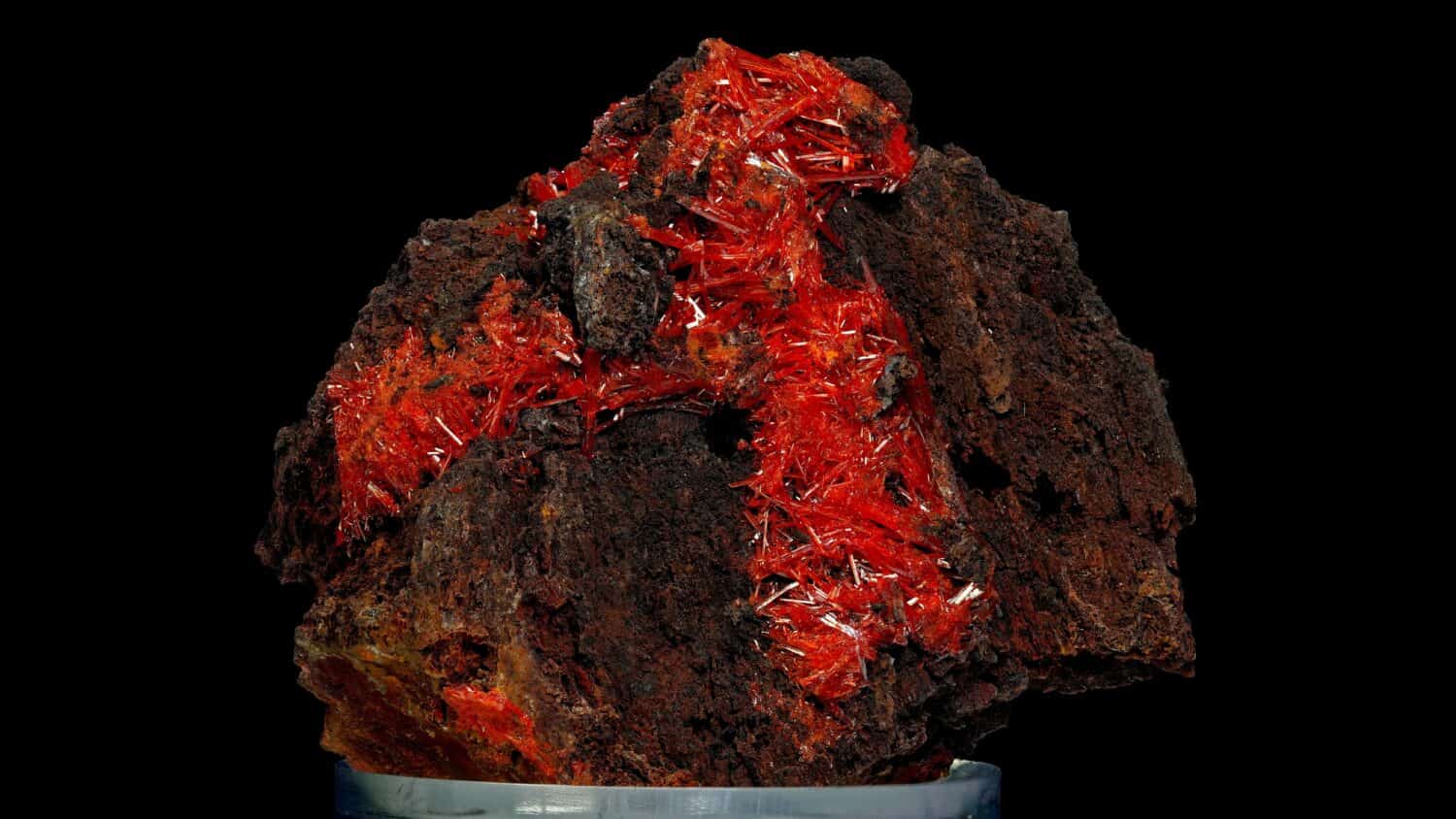
©Protean Visuals/Shutterstock.com
Although too soft for jewelry, crocoite’s rarity makes it popular with collectors. It has a vibrant yellow-orange to red-orange color and the best examples are crystals in a matrix.
A mine in Dundas, Tasmania yields the best crystals. In recognition, Tasmania declared crocoite its official state mineral in 2000.
44. Jet
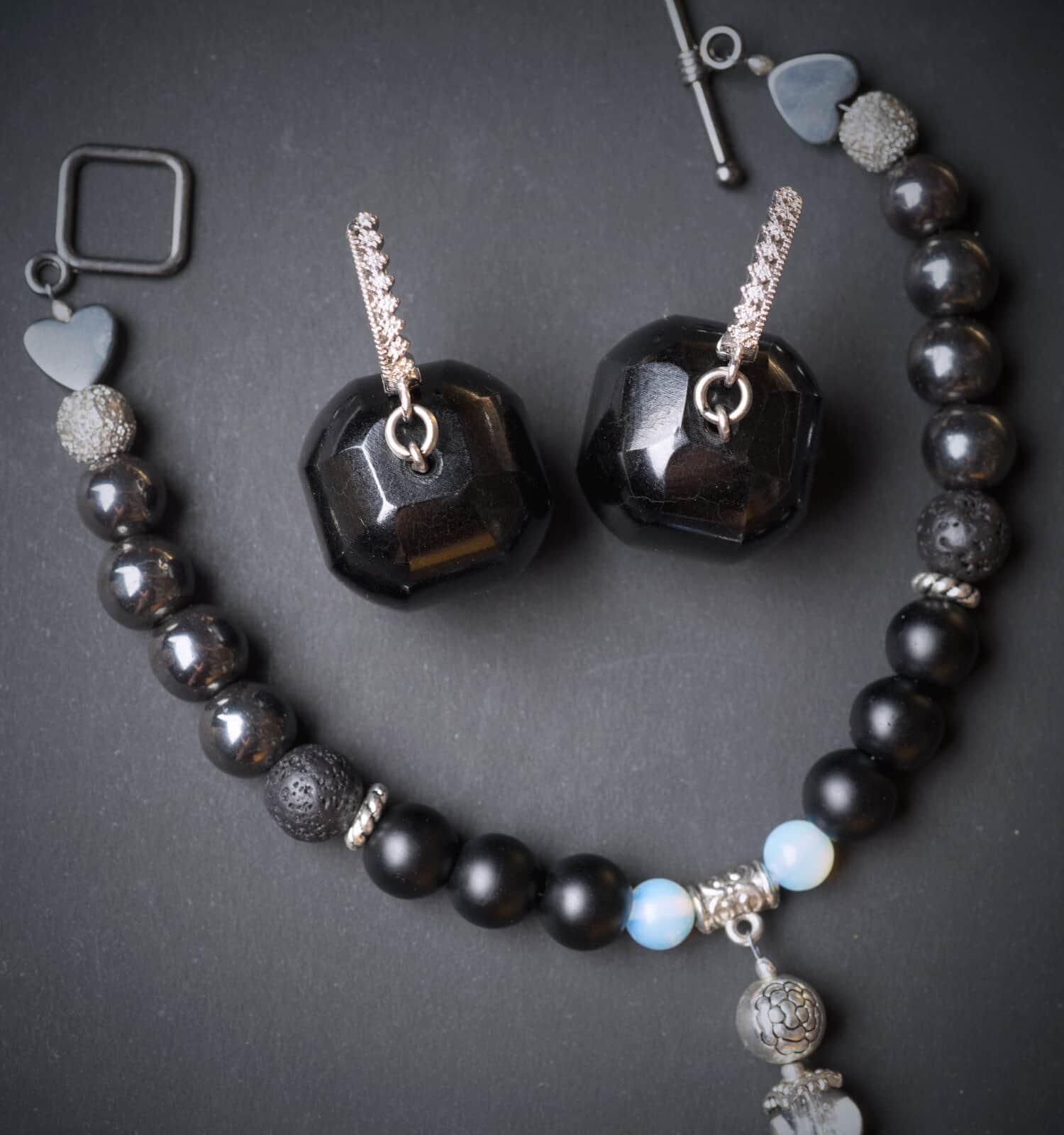
©anakondasp/Shutterstock.com
Jet’s use goes as far back as 10,000 BCE. It comes from decaying wood from Jurassic and Cretaceous-era Araucariaceae trees, buried and under immense pressure. Ancient carvings and jewelry have been found at numerous dig sites, and the gem was popular during the Victorian era.
Many people believe that this mineraloid helps ground and balance their energy. Although there are jet imitations, jet is noticeably warmer, especially glass imitations.
45. Kyanite
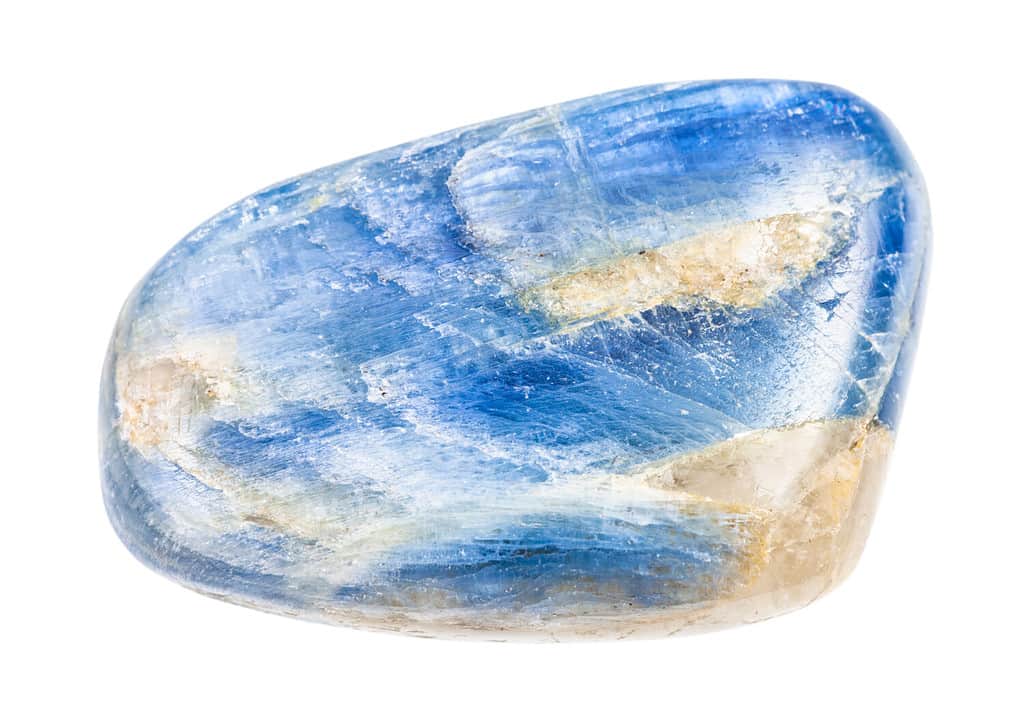
©vvoe/Shutterstock.com
Faceted kyanites are popular with collectors, they’re beautiful and come in many colors, including blue, orange, yellow, and pink. Depending on which direction you cut it, its hardness varies and can be 4.0 to 4.5, or 6.0 to 7.5 — making it especially difficult to facet without fracturing the stone.
Kyanites metaphysical uses include astral travel, past-life recall, and developing intuitive and psychic abilities. It’s mined in several countries, including Brazil, Madagascar, Zimbabwe, the United States, and Australia.
46. Mali Garnet
This rare garnet is a blend of two types — andradite and grossular. Only found in Mali, where scientists discovered it in 1994, Mali garnet ranges from green to yellow-green, gold, yellow, and brown.
47. Manganotantalite
Exceedingly rare, manganotantalite is a red-brown gem found in a few places around the world, including the U.S. states of California, Connecticut, and Virginia, in addition to several other regions like Sweden, Madagascar, and Brazil.
It’s hard to cut because of its cleavage, but well-cut gems are stunning!
48. Marcasite
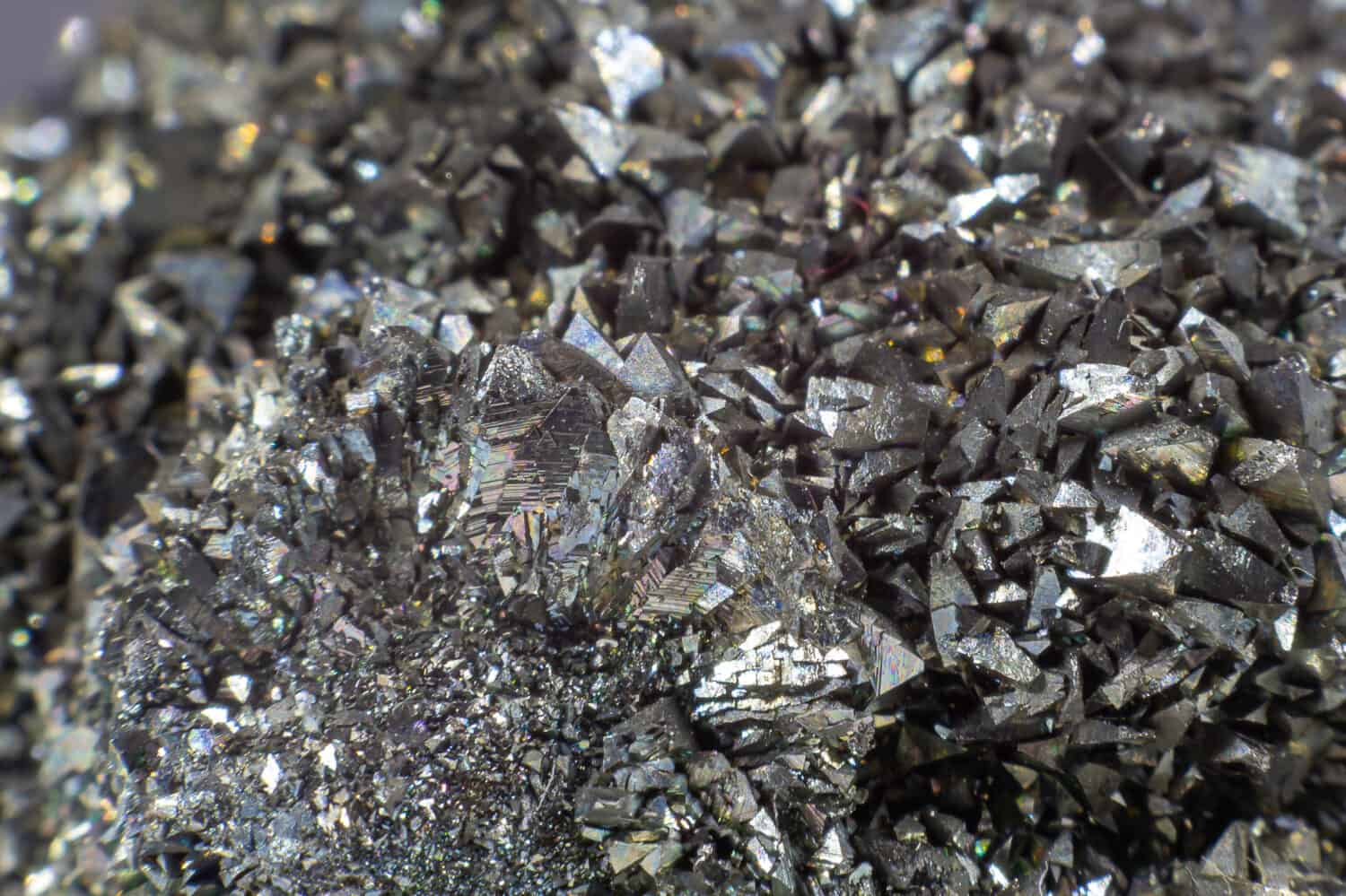
©JavierLJ/Shutterstock.com
Historically, marcasite’s brassy color and metallic sheen were popular as a decorative material. However, it’s brittle and isn’t used often in modern jewelry. However, most marcasite jewelry was actually pyrite, which has the same chemical structure but forms differently.
Metaphysically, people use it to align lower chakras and increase endurance. It and pyrite are used similarly because of their similar characteristics.
49. Nephrite Jade
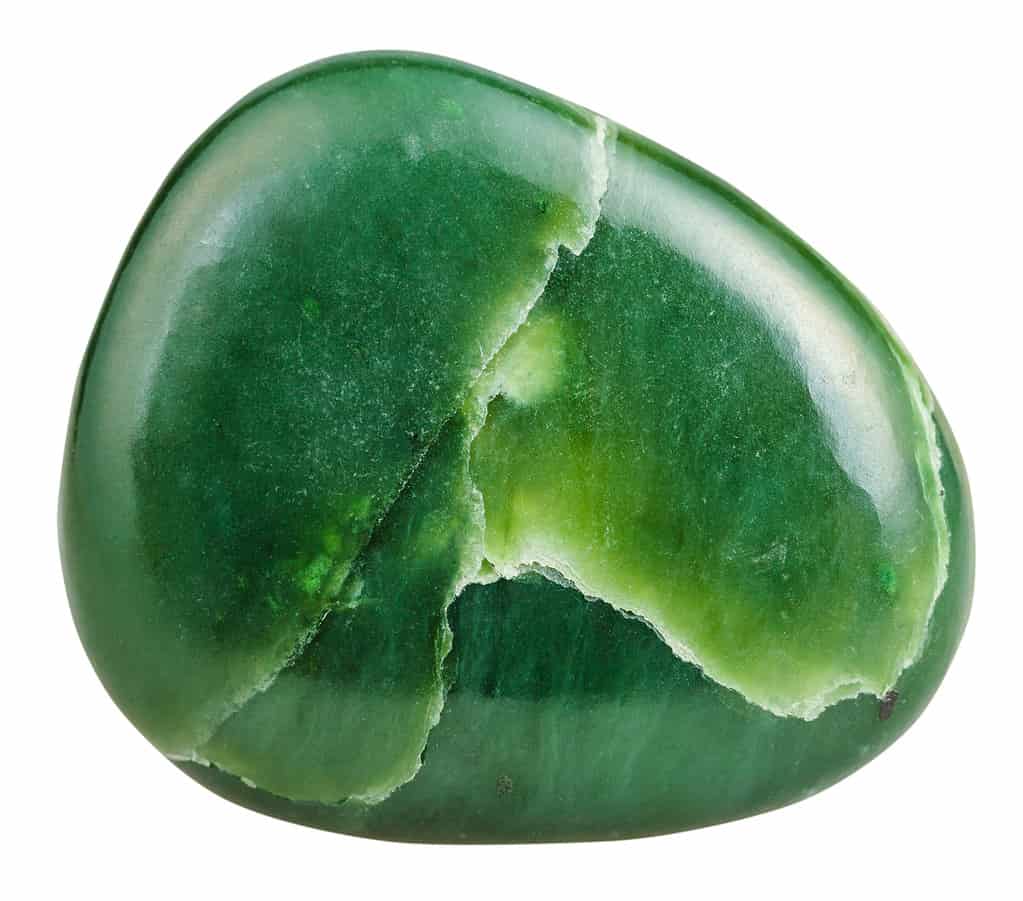
©vvoe/Shutterstock.com
This is one of two minerals that people call jade — nephrite and jadeite. Nephrite is the softer and more common of the two gems. Its structure is softer and fibrous, making it a wonderful carving stone that’s usually shades of beige or green.
People use nephrite for healing and protection; they also believe that it supports women who have difficulty with PMS.
50. Jadeite

©W. Scott McGill/Shutterstock.com
Jadeite is harder than nephrite and comes in at a hardness of about 6.5 to 7.0. It’s very tough, dense, and found in shades of green or white. This metamorphic rock was extremely valuable in ancient China and is the most expensive type of jade.
Considered a lucky gem, jadeite is worn as jewelry for luck, happiness, strength, and harmony.
